Editor's Note:
Dear Friend,
Samuel Johnson famously said, “People need to be reminded more often than they need to be instructed.” If you’re like me, you can probably relate to that quote. There are lots of things I know I need/want to do, but I just never remember to get around to them.
Well, to that end, we are reminding you that this year is a Hakhel year, when Jewish people gather together to study Torah and inspire each other. It’s a big deal. A. Very. Big. Deal.
Did you see our Hakhel page? It’s a place where you can sign up to host Hakhel gatherings, get ideas and tips, and learn more about the significance of this year.
So please consider this your reminder. Now is the time to sign up to be a Hakhel leader. To quote a famous home-improvement retailer: You can do it. We can help.
Sign up to be a Hakhel leader here.
Learn all about Hakhel here.
Check out our brand new Hakhel video here.
Happy Hakheling! #Unitethenation
Menachem Posner,
on behalf of the Chabad.org Editorial Team

Fortitude
Maybe you feel you just can’t hack it. You know there is nothing to fear, but you are afraid. Your mind affirms that there are no obstacles that cannot be overcome, but your heart is unable to overcome even its very own pangs.
It’s true; there are people who do not run from anything, who know no fear of beast or man, of life or of death. Even as they enter this world, they remain above and beyond. Their feet barely touch the earth.
They are the tzaddikim, those who never enter the monster’s lair. But if they never enter that place, how could they ever slay the dragon?
You, on the other hand, you face that awesome, internal monster called fear on its own ground.
So make a partnership. The tzaddik will lend you his power, and with it you will wrestle the dark monster to the dust.
For all of us are a single soul.
This Week's Features:
Printable Magazine

Dinah: The Woman Who Made a Difference
Parshat Vayishlach By Rochel Holzkenner

There is only one incident of sexual abuse that is recorded explicitly in theTorah. (Sarah was abducted by Pharaoh and again by Abimelech, but remained safely untouched in those kings’ palaces until she was liberated.) It is quite a tragic read, and the repercussions are curiously significant.
Jacob had twelve sons and one daughter, Dinah. As can be imagined, this daughter was well protected under the watchful eyes of her holy brothers.Sarah was abducted by Pharaoh and again by AbimelechFor many years Jacob lived in Charanand worked for his father-in-law, Laban. Eventually he decided to live independently from Laban, and he and his family packed up and traveled to the land of Canaan. In Canaan, they stopped in the city of Shechem with the thought of settling there. It was in Shechem that Jacob’s worst nightmare transpired.
Dinah, the daughter of Leah whom she bore to Jacob, went out to see the daughters of the land. Shechem, the son of Hamor the Hivite, prince of the land, saw her; and he abducted her, lay with her and afflicted her. (Genesis 34:1–2)
When Dinah left her family’s camp to meet the local women, she was abducted and raped by Shechem (a prince with the same name as the city). The Torah describes Shechem’s calculated steps: He saw her, he abducted her, he lay with her and he afflicted her. What is the difference between “lying with her” and “afflicting her”? Rashi quotes the Midrash and explains that he abused her in both a conventional way (“lying”) and an unconventional way (“affliction”). But perhaps the Torah is also describing the physical and emotional abuse that Dinah experienced with Shechem.
Any woman who has experienced sexual abuse understands the depth of affliction unleashed from one mere act of violation. It rips apart the very fabric of our feminine dignity, and it requires a lot of concentrated healing to restore our sense of self-respect. Dinah, a princess in the house of Jacob, was violated and afflicted.
In the beginning of this frightening story Dinah is introduced to us as the daughter of Leah, a fact that we already know. And the fact that Jacob is her father seems almost incidental: “Dinah, the daughter of Leah whom she bore to Jacob.” It sounds like her primary tie is to her mother. The Torah also gives us a context for her abduction: “[She] went out to see the daughters of the land.”
Rashi sees a significant connection between the description of Dinah as “the daughter of Leah” (and not Jacob) and the mention of her “going out to see the daughters of the land.” He explains:
Because of her going out, she is called “the daughter of Leah.” For [Leah], too, was an “outgoer,” as it is written, “Leah went out to greet him” (Genesis 30:16). Regarding her it was said, “Like mother, like daughter.”
How do you understand this Rashi? Is he suggesting that she was too outgoing, and that’s what got her into trouble? Is he somehow implicating Dinah in her own abduction?
But Rashi doesn’t just say she was outgoing; he says she was outgoing like her mother. When was Leah outgoing? Rashi highlights a particular incident to prove Leah’s extroversion: “Leah went out to greet him.” Leah’s son Reubenhad found plants called dudaim in the field and brought them to his mother.Rachel asked her sister to give her the dudaim that Reuben had just brought her. It is possible that the dudaim had potent medicinal qualities that increased a woman’s fertility, and Rachel was eager to conceive a child. Leah agreed to give her the dudaim in exchange for the opportunity to spend the night with Jacob, a night that Jacob had reserved for Rachel. Rachel agreed. Now they needed to tell Jacob of their deal in the most tactful and honorable manner. Leah was the one who told him.
And this is the verse that Rashi quotes to display Leah’s outgoing nature: “When Jacob came from the field in the evening, Leah went out toward him, and she said, ‘You shall come to me, because I have hired you with my son’sdudaim’; and he slept with her on that night” (Genesis 30:16). She didn’t wait for him to come home and possibly feel rejected by Rachel. She walked out to meet him, and explained to him what she and Rachel had arranged before he arrived at home. She was proactive in her consideration of her husband.
And that night she conceived her fifth son: “G‑d hearkened to Leah, and she conceived She was proactive in her consideration of her husbandand bore Jacob a fifth son” (Genesis 30:17). Rashi takes note of the words “G‑d hearkened to Leah” and explains why G‑d was so impressed with her: “She desired and was seeking means to increase the number of tribes.”
She went out to Jacob not only to be considerate of his dignity, but also because she was eager for the opportunity to conceive another child and increase the number of the Israelite tribes. G‑d was so pleased with Leah’s action that He blessed her with another son.
Clearly, Leah was outgoing in the most noble way. To compare Dinah’s extroverted nature to Leah’s is a complimentary description of Dinah, and certainly not an implication of her guilt. “Like mother, like daughter!”
Dinah was “the daughter of Leah whom she bore to Jacob.” Why is her relationship with Jacob mentioned as a mere byproduct of her being her mother’s daughter? There is an interesting story that sheds light on this question.
When Jacob first left the land of Charan, he prepared to meet his wicked brother, Esau. We read that “[Jacob] took his two wives, his two handmaidens and his eleven sons, and he crossed the ford of the Jabbok” (Genesis 32:23). Rashi asks,
Where was Dinah? Jacob had placed her in a chest and locked her in, lest Esau set his eyes on her. For this Jacob was punished, for had he not withheld her from his brother, perhaps she would have brought Esau back to the proper path. [The punishment was] that she fell into the hands of Shechem.
When it comes to the story of Dinah’s abduction, Jacob is mentioned minimally, because he precipitated her misfortune by insulating her before he met his brother. Now, it’s completely understandable that Jacob didn’t want his pure and beautiful daughter to marry his evil brother. He would have had to be crazy to marry her off to Esau. In fact, the Talmud tells us that Leah herself averted her original fate of marrying Esau through her prayers:
Because she expected to fall into Esau’s lot, she wept. Because everyone was saying, “Rebecca has two sons, and Laban has two daughters. The older [daughter] for the older [son], and the younger [daughter] for the younger [son].” (Talmud, Bava Batra 123a)
And yet we don’t find Leah punished for her prayers.
What is quite evident from this story is that Dinah in all probability would have influenced Esau to live an upstanding life. If not, why would Jacob have been so criticized for robbing Esau of this opportunity? Perhaps Leah accurately assessed her capabilities and knew that she wouldn’t have been able to influence him, and therefore there was no negative consequence to her prayers.
But Dinah was different. She was even more outgoing and efficacious than her mother. G‑d was disappointed that she didn’t have the opportunity to work her magic on Esau.
Both her positive, outgoing nature and her potential to influence one of the most corrupt men of her time are contained in the phrase that introduces us to her terrible encounter with Shechem: “Dinah, the daughter of Leah whom she bore to Jacob, went out to see the daughters of the land.”
Dinah, like her mother, was an outgoing and charismatic girl. It was only natural that after her family set up shop in the village of Shechem, she ventured out to see “the daughters of the land.” Perhaps she wanted to enlighten them about the monotheistic beliefs that her father and grandfather had been propagating throughout the Middle East. Unfortunately, she was badly hurt in the process.
And yet, despite the abuse that she endured, she still managed to profoundly impact her environment. Shechem himself seemed to be transformed by his short encounter with her. Shechem was a spoiled prince and a vile rapist. Shechem had no respect for women; he used them and disposed of them. And yet, after he was intimate with her, he began to develop tender feelings toward her:
His soul cleaved to Dinah, the daughter of Jacob; he loved the girl and spoke to the girl’s heart. And Shechem spoke to his father, Hamor, saying, “Take this girl for me as a wife.” (Genesis 34:3–4)
Why did he feel so connected to her? How could he have loved her? What did he say to her? Perhaps he was apologizing for what he had done, and was trying to win her approval. Instead of using her and trashing her, he suddenly wanted to marry her, and humbly sought Why did he feel so connected to her? How could he have loved her?the consent of her father, Jacob. In fact, he was willing to pay top dollar just to have Dinah’s hand in marriage:
Hamor spoke with them, saying: “My son, Shechem, his soul has a liking for your daughter. Please give her to him for a wife. . . . Shechem said to her father and to her brothers, “May I find favor in your eyes. Whatever you tell me, I will give.” (Genesis 34:8–11)
Of course, Dinah would never consent to marry her abuser; but nonetheless, the shift in Shechem cannot be ignored.
Dinah’s brothers pretended to agree to Shechem’s request on the condition that Hamor (Shechem’s father), Shechem, and all of the people of their village circumcise themselves. Not only did Hamor and Shechem agree to this condition, but they persuaded all of the townsfolk to agree. At face value, this was all a ploy to weaken the inhabitants of the town so that the brothers could safely rescue Dinah. Yes, the circumcision was strategic, but it was also a rectification for the people of Shechem. Circumcision represents the mitigation of sexual impulsivity and self-centered lust. Perhaps it was through Shechem’s commitment to undergo a circumcision that he rectified his aggressive and dominant actions. The circumcision was also part of a conversion process to the Jewish religion. Both the men and the women willingly converted to Jacob’s monotheistic beliefs.
Yet, in the most zealous act of chivalry, two of Dinah’s brothers conspired not only to rescue Dinah, but to repay Shechem for the terrible travesty of violating their sister. Simeon and Levi decided to kill Shechem and all the men of the village, who had stood silently by while Shechem committed this injustice.
Jacob did not know that his sons had planned to mete out judgement on the whole town. When he found out they they had wiped out the entire city to avenge their sister’s violation, he rebuked them:
“You have troubled me, to discredit me among the inhabitants of the land, among the Canaanites and among the Perizzites. I am few in number, and they will gather against me, and I and my household will be destroyed.” (Genesis 34:30)
The story ends with the brothers’ response to Jacob. They ask him a rhetorical question that embodies the high price they were willing to pay for their sister’s protection: “Shall he make our sister like a harlot?”
And yet, amidst the tragic circumstances, Dinah still managed to be quite influential. She was a born leader, like her mother, outgoing and influential. The women of the town of Shechem retained a relationship with Dinah’s family. Both Dinah and Leah are praised for “going out.”
The Midrash (Yalkut Shimoni 134) tells us that Dinah conceived a child from her union with Shechem, a daughter named Asenath. Asenath eventually moved to Egypt and worked in the house of Potiphar. Joseph, who was already a viceroy to the king, met her and was impressed by her commitment to her faith, even in Egypt. He married Asenath (his niece), and they had two children together,Manasseh and Ephraim. Although these sons were born outside of the Holy Land and grew up in the lap of luxury, they were so spiritually centered that they surpassed even their cousins who were raised in Canaan. Jacob gave Joseph’s sons special treatment, blessing them in the same way that he blessed his sons. Eventually, Joseph’s sons merited to head their own tribes, something that was reserved for the sons of Jacob and not his grandchildren. It was Asenath, the daughter of Dinah and Shechem, who raised these two child prodigies all alone in Egypt.
Despite the pain that Dinah endured, the Torah prefaces the story with the message that Dinah, like Leah, was outgoing and influential. The Lubavitcher Rebbe, Rabbi Menachem Mendel Schneerson, of righteous memory, sees Dinah as the Torah’s first prototype of female leadership.
Sarah, Rebecca, Rachel and Leah were opinionated and decisive. On numerous occasions, they powerfully influenced their husbands and children. They were paradigms of the akeret habyit, the woman who builds her On numerous occasions, they powerfully influenced their husbands and childrenhome and lays the foundation for the next generation. But the Torah gives us no indication that they were influential outside of their home.1 Their lives were in sync with King David’s description of the Jewish woman, the daughter of the king: “The entire glory of the daughter of the king is her inwardness” (Psalms 45:13). She is glorified because of her inwardness—her first priority is her inner circle. This regal woman is dedicated to cultivating her marriage and investing in her children’s wellbeing. Like a true princess, her regality stems from her focus on what is important, not on what is popular. She doesn’t need to extend beyond her home life and promote herself publicly in order to validate her worth.
So, what would King David say about some of today’s “out there” women, many of whom are making a significant mark on society? Have they lost their opportunity for regal living?
Dinah was unique. She was gifted with a potent sphere of influence. Her charisma naturally attracted other people to take her lead. Dinah was drawn toward other women, and even in a new environment she was naturally social. Ultimately, she always influenced other people to become more spiritually sensitive.
Dinah is every woman who is naturally influential. For her, it would be a loss to hide in a box. She’s got her work cut out for her, and with conscious effort she can become an inspirational leader.
What about modesty? What about the inwardness that generates feminine glory? Yes, she has a higher calling for greater exposure, but at what personal cost? Does she have to relinquish the glory that comes from living a more private life?
The Rebbe advises female leaders to utilize their influence and still retain their modesty. That’s a difficult balance to maintain. Personal attention can become addictive. A more provocative way of dress and a flirtatious conversation can open doors for influential women. Modesty can feel like an unfair inhibition for female leaders.
But perhaps along with the loss of modesty comes the loss of focused influence: Does my exposure make people think more about G‑d, or more about me? A woman is most effective at making an inspirational mark on the world when she carries the allure of dignity. It’s an allure that modest dress and behavior naturally breeds. For her, King David’s “inwardness” doesn’t mean staying inside the house as much as it means staying true to herself. Modest leadership, in essence, is saying, “I have an authentic message to share, but I’m not prepared to compromise any boundaries to hook you in.” Instead, the female leader sets a tone of warmth and sincerity that speak for itself.
The Rebbe argues that the feminine model of leadership is even more effective than the typical masculine model of leadership, which tends to be more domineering and authoritarian. The feminine influence is predicated upon sincerity, selflessness and nurturing.
FOOTNOTES
1. The Midrash tells us that Abraham converted men to monotheism, and Sarah converted the women. The matriarchs did influence others outside their homes, but that they didn’t go out to influence; rather, they brought people into their homes to be influenced.
BY ROCHEL HOLZKENNER

Dinah: The Woman Who Made a Difference
Parshat Vayishlach By Rochel Holzkenner


There is only one incident of sexual abuse that is recorded explicitly in theTorah. (Sarah was abducted by Pharaoh and again by Abimelech, but remained safely untouched in those kings’ palaces until she was liberated.) It is quite a tragic read, and the repercussions are curiously significant.
Jacob had twelve sons and one daughter, Dinah. As can be imagined, this daughter was well protected under the watchful eyes of her holy brothers.Sarah was abducted by Pharaoh and again by AbimelechFor many years Jacob lived in Charanand worked for his father-in-law, Laban. Eventually he decided to live independently from Laban, and he and his family packed up and traveled to the land of Canaan. In Canaan, they stopped in the city of Shechem with the thought of settling there. It was in Shechem that Jacob’s worst nightmare transpired.
Dinah, the daughter of Leah whom she bore to Jacob, went out to see the daughters of the land. Shechem, the son of Hamor the Hivite, prince of the land, saw her; and he abducted her, lay with her and afflicted her. (Genesis 34:1–2)
When Dinah left her family’s camp to meet the local women, she was abducted and raped by Shechem (a prince with the same name as the city). The Torah describes Shechem’s calculated steps: He saw her, he abducted her, he lay with her and he afflicted her. What is the difference between “lying with her” and “afflicting her”? Rashi quotes the Midrash and explains that he abused her in both a conventional way (“lying”) and an unconventional way (“affliction”). But perhaps the Torah is also describing the physical and emotional abuse that Dinah experienced with Shechem.
Any woman who has experienced sexual abuse understands the depth of affliction unleashed from one mere act of violation. It rips apart the very fabric of our feminine dignity, and it requires a lot of concentrated healing to restore our sense of self-respect. Dinah, a princess in the house of Jacob, was violated and afflicted.
In the beginning of this frightening story Dinah is introduced to us as the daughter of Leah, a fact that we already know. And the fact that Jacob is her father seems almost incidental: “Dinah, the daughter of Leah whom she bore to Jacob.” It sounds like her primary tie is to her mother. The Torah also gives us a context for her abduction: “[She] went out to see the daughters of the land.”
Rashi sees a significant connection between the description of Dinah as “the daughter of Leah” (and not Jacob) and the mention of her “going out to see the daughters of the land.” He explains:
Because of her going out, she is called “the daughter of Leah.” For [Leah], too, was an “outgoer,” as it is written, “Leah went out to greet him” (Genesis 30:16). Regarding her it was said, “Like mother, like daughter.”
How do you understand this Rashi? Is he suggesting that she was too outgoing, and that’s what got her into trouble? Is he somehow implicating Dinah in her own abduction?
But Rashi doesn’t just say she was outgoing; he says she was outgoing like her mother. When was Leah outgoing? Rashi highlights a particular incident to prove Leah’s extroversion: “Leah went out to greet him.” Leah’s son Reubenhad found plants called dudaim in the field and brought them to his mother.Rachel asked her sister to give her the dudaim that Reuben had just brought her. It is possible that the dudaim had potent medicinal qualities that increased a woman’s fertility, and Rachel was eager to conceive a child. Leah agreed to give her the dudaim in exchange for the opportunity to spend the night with Jacob, a night that Jacob had reserved for Rachel. Rachel agreed. Now they needed to tell Jacob of their deal in the most tactful and honorable manner. Leah was the one who told him.
And this is the verse that Rashi quotes to display Leah’s outgoing nature: “When Jacob came from the field in the evening, Leah went out toward him, and she said, ‘You shall come to me, because I have hired you with my son’sdudaim’; and he slept with her on that night” (Genesis 30:16). She didn’t wait for him to come home and possibly feel rejected by Rachel. She walked out to meet him, and explained to him what she and Rachel had arranged before he arrived at home. She was proactive in her consideration of her husband.
And that night she conceived her fifth son: “G‑d hearkened to Leah, and she conceived She was proactive in her consideration of her husbandand bore Jacob a fifth son” (Genesis 30:17). Rashi takes note of the words “G‑d hearkened to Leah” and explains why G‑d was so impressed with her: “She desired and was seeking means to increase the number of tribes.”
She went out to Jacob not only to be considerate of his dignity, but also because she was eager for the opportunity to conceive another child and increase the number of the Israelite tribes. G‑d was so pleased with Leah’s action that He blessed her with another son.
Clearly, Leah was outgoing in the most noble way. To compare Dinah’s extroverted nature to Leah’s is a complimentary description of Dinah, and certainly not an implication of her guilt. “Like mother, like daughter!”
Dinah was “the daughter of Leah whom she bore to Jacob.” Why is her relationship with Jacob mentioned as a mere byproduct of her being her mother’s daughter? There is an interesting story that sheds light on this question.
When Jacob first left the land of Charan, he prepared to meet his wicked brother, Esau. We read that “[Jacob] took his two wives, his two handmaidens and his eleven sons, and he crossed the ford of the Jabbok” (Genesis 32:23). Rashi asks,
Where was Dinah? Jacob had placed her in a chest and locked her in, lest Esau set his eyes on her. For this Jacob was punished, for had he not withheld her from his brother, perhaps she would have brought Esau back to the proper path. [The punishment was] that she fell into the hands of Shechem.
When it comes to the story of Dinah’s abduction, Jacob is mentioned minimally, because he precipitated her misfortune by insulating her before he met his brother. Now, it’s completely understandable that Jacob didn’t want his pure and beautiful daughter to marry his evil brother. He would have had to be crazy to marry her off to Esau. In fact, the Talmud tells us that Leah herself averted her original fate of marrying Esau through her prayers:
Because she expected to fall into Esau’s lot, she wept. Because everyone was saying, “Rebecca has two sons, and Laban has two daughters. The older [daughter] for the older [son], and the younger [daughter] for the younger [son].” (Talmud, Bava Batra 123a)
And yet we don’t find Leah punished for her prayers.
What is quite evident from this story is that Dinah in all probability would have influenced Esau to live an upstanding life. If not, why would Jacob have been so criticized for robbing Esau of this opportunity? Perhaps Leah accurately assessed her capabilities and knew that she wouldn’t have been able to influence him, and therefore there was no negative consequence to her prayers.
But Dinah was different. She was even more outgoing and efficacious than her mother. G‑d was disappointed that she didn’t have the opportunity to work her magic on Esau.
Both her positive, outgoing nature and her potential to influence one of the most corrupt men of her time are contained in the phrase that introduces us to her terrible encounter with Shechem: “Dinah, the daughter of Leah whom she bore to Jacob, went out to see the daughters of the land.”
Dinah, like her mother, was an outgoing and charismatic girl. It was only natural that after her family set up shop in the village of Shechem, she ventured out to see “the daughters of the land.” Perhaps she wanted to enlighten them about the monotheistic beliefs that her father and grandfather had been propagating throughout the Middle East. Unfortunately, she was badly hurt in the process.
And yet, despite the abuse that she endured, she still managed to profoundly impact her environment. Shechem himself seemed to be transformed by his short encounter with her. Shechem was a spoiled prince and a vile rapist. Shechem had no respect for women; he used them and disposed of them. And yet, after he was intimate with her, he began to develop tender feelings toward her:
His soul cleaved to Dinah, the daughter of Jacob; he loved the girl and spoke to the girl’s heart. And Shechem spoke to his father, Hamor, saying, “Take this girl for me as a wife.” (Genesis 34:3–4)
Why did he feel so connected to her? How could he have loved her? What did he say to her? Perhaps he was apologizing for what he had done, and was trying to win her approval. Instead of using her and trashing her, he suddenly wanted to marry her, and humbly sought Why did he feel so connected to her? How could he have loved her?the consent of her father, Jacob. In fact, he was willing to pay top dollar just to have Dinah’s hand in marriage:
Hamor spoke with them, saying: “My son, Shechem, his soul has a liking for your daughter. Please give her to him for a wife. . . . Shechem said to her father and to her brothers, “May I find favor in your eyes. Whatever you tell me, I will give.” (Genesis 34:8–11)
Of course, Dinah would never consent to marry her abuser; but nonetheless, the shift in Shechem cannot be ignored.
Dinah’s brothers pretended to agree to Shechem’s request on the condition that Hamor (Shechem’s father), Shechem, and all of the people of their village circumcise themselves. Not only did Hamor and Shechem agree to this condition, but they persuaded all of the townsfolk to agree. At face value, this was all a ploy to weaken the inhabitants of the town so that the brothers could safely rescue Dinah. Yes, the circumcision was strategic, but it was also a rectification for the people of Shechem. Circumcision represents the mitigation of sexual impulsivity and self-centered lust. Perhaps it was through Shechem’s commitment to undergo a circumcision that he rectified his aggressive and dominant actions. The circumcision was also part of a conversion process to the Jewish religion. Both the men and the women willingly converted to Jacob’s monotheistic beliefs.
Yet, in the most zealous act of chivalry, two of Dinah’s brothers conspired not only to rescue Dinah, but to repay Shechem for the terrible travesty of violating their sister. Simeon and Levi decided to kill Shechem and all the men of the village, who had stood silently by while Shechem committed this injustice.
Jacob did not know that his sons had planned to mete out judgement on the whole town. When he found out they they had wiped out the entire city to avenge their sister’s violation, he rebuked them:
“You have troubled me, to discredit me among the inhabitants of the land, among the Canaanites and among the Perizzites. I am few in number, and they will gather against me, and I and my household will be destroyed.” (Genesis 34:30)
The story ends with the brothers’ response to Jacob. They ask him a rhetorical question that embodies the high price they were willing to pay for their sister’s protection: “Shall he make our sister like a harlot?”
And yet, amidst the tragic circumstances, Dinah still managed to be quite influential. She was a born leader, like her mother, outgoing and influential. The women of the town of Shechem retained a relationship with Dinah’s family. Both Dinah and Leah are praised for “going out.”
The Midrash (Yalkut Shimoni 134) tells us that Dinah conceived a child from her union with Shechem, a daughter named Asenath. Asenath eventually moved to Egypt and worked in the house of Potiphar. Joseph, who was already a viceroy to the king, met her and was impressed by her commitment to her faith, even in Egypt. He married Asenath (his niece), and they had two children together,Manasseh and Ephraim. Although these sons were born outside of the Holy Land and grew up in the lap of luxury, they were so spiritually centered that they surpassed even their cousins who were raised in Canaan. Jacob gave Joseph’s sons special treatment, blessing them in the same way that he blessed his sons. Eventually, Joseph’s sons merited to head their own tribes, something that was reserved for the sons of Jacob and not his grandchildren. It was Asenath, the daughter of Dinah and Shechem, who raised these two child prodigies all alone in Egypt.
Despite the pain that Dinah endured, the Torah prefaces the story with the message that Dinah, like Leah, was outgoing and influential. The Lubavitcher Rebbe, Rabbi Menachem Mendel Schneerson, of righteous memory, sees Dinah as the Torah’s first prototype of female leadership.
Sarah, Rebecca, Rachel and Leah were opinionated and decisive. On numerous occasions, they powerfully influenced their husbands and children. They were paradigms of the akeret habyit, the woman who builds her On numerous occasions, they powerfully influenced their husbands and childrenhome and lays the foundation for the next generation. But the Torah gives us no indication that they were influential outside of their home.1 Their lives were in sync with King David’s description of the Jewish woman, the daughter of the king: “The entire glory of the daughter of the king is her inwardness” (Psalms 45:13). She is glorified because of her inwardness—her first priority is her inner circle. This regal woman is dedicated to cultivating her marriage and investing in her children’s wellbeing. Like a true princess, her regality stems from her focus on what is important, not on what is popular. She doesn’t need to extend beyond her home life and promote herself publicly in order to validate her worth.
So, what would King David say about some of today’s “out there” women, many of whom are making a significant mark on society? Have they lost their opportunity for regal living?
Dinah was unique. She was gifted with a potent sphere of influence. Her charisma naturally attracted other people to take her lead. Dinah was drawn toward other women, and even in a new environment she was naturally social. Ultimately, she always influenced other people to become more spiritually sensitive.
Dinah is every woman who is naturally influential. For her, it would be a loss to hide in a box. She’s got her work cut out for her, and with conscious effort she can become an inspirational leader.
What about modesty? What about the inwardness that generates feminine glory? Yes, she has a higher calling for greater exposure, but at what personal cost? Does she have to relinquish the glory that comes from living a more private life?
The Rebbe advises female leaders to utilize their influence and still retain their modesty. That’s a difficult balance to maintain. Personal attention can become addictive. A more provocative way of dress and a flirtatious conversation can open doors for influential women. Modesty can feel like an unfair inhibition for female leaders.
But perhaps along with the loss of modesty comes the loss of focused influence: Does my exposure make people think more about G‑d, or more about me? A woman is most effective at making an inspirational mark on the world when she carries the allure of dignity. It’s an allure that modest dress and behavior naturally breeds. For her, King David’s “inwardness” doesn’t mean staying inside the house as much as it means staying true to herself. Modest leadership, in essence, is saying, “I have an authentic message to share, but I’m not prepared to compromise any boundaries to hook you in.” Instead, the female leader sets a tone of warmth and sincerity that speak for itself.
The Rebbe argues that the feminine model of leadership is even more effective than the typical masculine model of leadership, which tends to be more domineering and authoritarian. The feminine influence is predicated upon sincerity, selflessness and nurturing.
FOOTNOTES
1. The Midrash tells us that Abraham converted men to monotheism, and Sarah converted the women. The matriarchs did influence others outside their homes, but that they didn’t go out to influence; rather, they brought people into their homes to be influenced.
BY ROCHEL HOLZKENNER

Rochel is a mother of four children and the co-director of Chabad of Las Olas, Fla., serving the community of young professionals. She is a high-school teacher and a freelance writer—and a frequent contributor to Chabad.org. She lectures extensively on topics of Kabbalah and feminism, and their application to everyday life. Rochel holds an MS in Brain Research from Nova SE University.
Essay
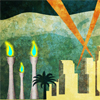
Jews Don’t Believe in Angels By Tzvi Freeman
But do angels believe in us?

Ring, Round and Roof
Based on the teachings of the Lubavitcher Rebbe
Eliezer gave Rebecca a ring, betrothing her to Isaac; ever since, rings, circles and enveloping structures have facilitated the union of man and woman. The Kabbalistic masters delve into the mystery of the circle to understand the unifying force that violates all the laws of ego and identity.
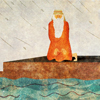
Everything About Enosh
By Shaul Wolf
There is very little mention of him in the Torah, and most of what we know about him and his times is from Midrashic and Talmudic sources.
Your Questions

Why Do Jewish Brides Wear White?
By Yehuda Shurpin
I recently read that this actually originated with Queen Victoria in the mid-19th century.
Story

The Monster in the Woods
By Eli Landes
I don’t want to enter the Monster’s house—a thousand stories detail the folly in such an action—but what can I do?
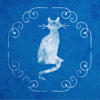
The Cat
By Yanki Tauber
Everyone has a right to an opinion. It is inevitable, however, that certain opinions will carry more weight than others.
Parshah
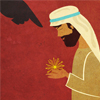
Feeling the Fear
By Rabbi Jonathan Sacks
Hearing that his brother Esau is coming to meet him with a force of four hundred men, Jacob was terrified.
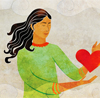
Dinah: The Woman Who Made a Difference
By Rochel Holzkenner
There is only one incident of sexual abuse that is recorded explicitly in the Torah.
From the Chabad.org Blog
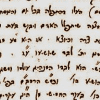
Classic Chabad Manuscript Now Online in English
The work has a long and storied history.

Icing on Rabbi Kaplan’s Cake
By Shmuel Lifshitz
Celebrating the completion of the Mishneh Torah, Sefer Hamitzvot and an epic project
Women

Morning in Jerusalem
By Elana Mizrahi
A young mother shares what keeps her going, despite all the stabbings.

When I Got to Planet Lubavitch
By Lieba Rudolph
I’ve never actually had a conversation with an alien, but I do think I have some idea what it feels like to be one.
Jewish News
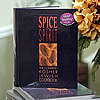
How One Purple Book Revolutionized Kosher Cooking
By Dovid Margolin
What started out as a volunteer project became a trailblazing endeavor that permanently changed Jewish cooking.
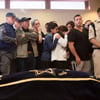
Israeli Teen Killed at Highway Gas Station; Second Young Victim Laid to Rest
By Chabad.org Staff
Continued violence includes attack near Machane Yehuda outdoor market.
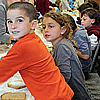
Toronto Kids Learn About Giving Back
By Chabad.org Staff
Upcoming program: Wrapping Chanukah gifts for hospitalized kids.
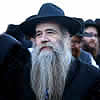
Saint-Denis Rabbi’s Pledge: Our Public Menorah Will Shine Even Brighter This Year
By Faygie Levy Holt
Local rabbi responds after police kill two and arrest seven in area north of Paris.
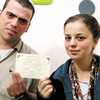
Guests From Around the World Heading to Grieving Couple's Wedding
By Faygie Levy Holt
Raffles at Chabad centers send visitors and gifts to Jerusalem.
Lifestyle
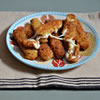
Fried Mozzarella Sticks for Chanukah
By Miriam Szokovski
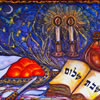
Artwork of the Week: Shabbat Shalom!
By Rae Chichilnitsky
Chabad.org Magazine - Editor: Yanki Tauber
© Copyright 2015, all rights reserved.
Essay
Jews Don’t Believe in Angels
By Tzvi Freeman

Los Angeles, 7 AM, at the curb, waiting for my Lyft.1 A jeep-thing pulls up, and I jump in. Doesn’t take long to realize this is no LA driver. We are weaving through traffic. We are being tough and mean. This is a NYC driver.
“So, what do you think of the city?” I ask.
“Los Angeles,” he says.
We spin a left through a gap in the traffic onto a side street. And we’re not slowing down for the bumps.
“Yeah,” I reply. Like, where else are we?
“The city is the angels. You wish, the city gives to you.”
Sharp right turn and we’re already on Olympic Blvd.
“You want chemicals. The city got it for you waiting. You want other stuff, the angels got that too, 24/7, what you want whenever you want. Just ask the city. Ask the angels. They give you.”
Slip into the parking lane just before the light turns green. Step on the gas and we’re ahead.
“Wanna be rich? There’s jobs, there’s deals. No problem, just ask the city.”
Nudged in between a Subaru and a Beemer.
“You wanna have your name up there in lights? You wanna be rich and famous? Hey, just ask the angels! They’ll give that to you too!”
Subaru guy doesn’t seem too happy. Anyways, we’re out of there fast.
“So,” I ask, “that’s why so many people here are so messed up?”
“Hey, that’s why so many them peoples so messed up, man! ’Cuz they get what whatever they ask! And they don’t know what to ask!”
I’m clutching my seatbelt. I’m thinking, “So, I don’t even have to rub the genie jar. I’m inside it. What do I want to ask the angels?”
But we’re there already. And when I’m there, and out, it hits me. “I don’t ask no angels for nothing! I ask only the Creator of All Multiple Universes in person! Angels? I’ll tell them what to do.”
That’s what it means to be a Jew. A child of Israel. That’s what the word means:
Your name shall no longer be called Jacob, but Israel, for you have commanded angels and men, and you have won.2
The Angels Split
A story, from the Talmud3:
Rabbi Pinchas ben Yair was on his way to perform the mitzvah of redeeming captives. At a certain point, the Ginai River blocked his path.
He commanded, “Ginai, split your waters so I may pass through!”
(Who is he talking to? A river? Rivers talk? He’s speaking to the angel of the river. Because each thing in our world has an angel appointed over it. Not just Los Angeles.)
The river replied, “Look, I totally understand. You are going to perform the will of your Master. But like, whose will do you think I’m performing, flowing like this? The difference is that you may or may not succeed. But, me? Hey, I’ve been doing this with hardly a glitch for millennia!”
He responded, “Split. Because if you don’t, I will decree that water should not flow through you forever!”
The river split.
The Great Maggid of Mezeritch asked: The river had a reasonable retort to Rabbi Pinchas. What, Rabbi Pinchas ben Yair is not up to a good Talmudic debate? Just “get out of my way” and that’s it?
So the Maggid explained: We need to hear his words more carefully—as did the river (or the angel appointed over that river). He didn’t just say, “Water will not flow in you.” He added the word “forever.” Forever—not in the future, not now, and not ever before, either.4
He said, “River, if you don’t split, you were never here. Water never flowed here, and nothing ever stood in my path. Nobody will ever even remember this story, because it never happened. And if so, you were never doing the will of your Master, because you didn’t exist, and you have no argument. So split. Now.”
Transcendental Angels
You see, when the universe first emerged into being, it did so conditionally. Nothing exists “just because.” Everything is assigned a purpose, a meaning that transcends its own nature. Like the words of a poem or the notes of a melody, they play their part to allow in a beauty much greater than they themselves contain. A river, a tree, a bird, every human being—they are all windows made to open and close, so that the infinite may enter whenever and wherever it so desires.
Rabbi Yochanan said, “When G‑d said, ‘Let the waters gather in one place,’ and thereby created the oceans, the rivers and seas, He made a condition with the sea: When Israel will arrive at the sea on their way from Egypt, it must part.”
R. Yirmiyah b. Elazar said, “Not with the sea alone did G‑d make a stipulation, but with everything which was created in the six days of creation.”5
The very nature of things is to allow in that which transcends nature. If Rabbi Pinchas ben Yair is on his way to do a mitzvah—to redeem captives of this mean and ugly world and to let some beauty enter—no natural phenomenon can stand in his way. And so too with any upright person who is out to do good. There will be challenges; the world always challenges anything good. But when you stand your ground, those challenges are commanded to melt before you.
The City Splits
Just a week before, I saw it happen. A few stubborn Jews hot on the International Shabbat Project decided that 3,000 Jews have to eat together on a Shabbat night—and the only place to do that was Pico Blvd.
The city told them that’s not possible. The police told them they were nuts. Los Angeles has the worst traffic of any city in America, tenth worst in the world, with 80% congestion at rush hour. Friday evening is off the charts, and that leg of Pico—five city blocks that these guys wanted to cut off—is one of the city’s densest arteries.
“Make your dinner on Sunday!” the angels said. “We have a job to do!”
But the children of Israel stood their ground, and the boulevard split before them. The police redirected the traffic; the city provided security guards every ten feet plus snipers on the rooftops. The caterers served from shopping carts. Thousands of Jews ate, sang and danced on the street—Jews from every community and background you could imagine.
Shabbat, a time beyond time, descended upon the city. “It feels like Jerusalem!” many told me. Others exclaimed, “It feels like Moshiach is already here!”
We aren’t here to pander to the angels and the nature of things. Not to ask, “What can this city give me?” We are here to tell the city what it must be—even if that means the city should allow the impossible.
We are here to tell the city what is beautiful, and that it is meant to be part of that beauty. That families should eat together, communities should come together, and we should all celebrate with food, wine, song and dance because “in six days G‑d created the heavens and the earth, and on the seventh day He rested.” And so we too shall turn off our mobile devices, leave our cars in the garage, and delight in divine rest.
My Lyft app is asking me to rate my driver. I give him five stars out of five. To get me across the city that fast, and alive, I figure he must have been an angel.
Rabbi Tzvi Freeman, a senior editor at Chabad.org, also heads our Ask The Rabbi team. He is the author of Bringing Heaven Down to Earth. To subscribe to regular updates of Rabbi Freeman's writing, visitFreeman Files subscription.
FOOTNOTES
1. Lyft is a car service accessible by a mobile phone app.
2. Genesis 32:29.
3. Chullin 7a.
4. Ohr Torah, Parshat Beshalach.
5. Bereishit Rabbah 5:5. Adapted for clarity.
© Copyright 2015, all rights reserved.
Essay
Ring, Round and Roof
Based on the teachings of the Lubavitcher Rebbe

The circle marks the boundary between the defined area within and the unquantifiable expanse without, between the measurable and the infinite, between the known and the unknowable. Indeed, the circle itself is a mystery, its value revealed only as the enigmatic π, which is not a number at all but a string of numbers that stretch on to fathomless infinity.
In the teachings of Kabbalah, the circle represents the encompassing light that frames our reality. Kabbalah differentiates between two types of divine light: a pervading inner light (ohr penimi), and a transcendent encompassing light (ohr makif).
Inner light describes a flow of divine energy that conforms to the parameters of our lives. The workings of nature, for example, or the processes of history, are in truth divine influences upon our existence; but these are divine influences that have assumed a form and nature that we can comprehend, relate to and internalize. The Torah, which is the divine wisdom and will made palpable to the human mind and implementable by human behavior, is another (albeit loftier) example of inner light.
But then there are the supra-natural, supra-rational manifestations of divine light. We call these miracles, existential mysteries, and mind-blowing experiences; we cannot understand them or assimilate them, only accept them and submit to them. This is not to say that the encompassing light is something that is outside of our being. In the words of the Tanya, it “penetrates our reality from head to foot, to its innerness and the inside of its innerness”: it is as basic (indeed, more basic) to our existence as the inner light. Yet, even as it suffuses our being, it remains aloof from us and beyond us, holding us in its embrace while eluding our attempts to grasp it and define it.
The soul of man, which was created in the image of G‑d, also emits both an inner and an encompassing light. It manifests itself via finite and definitive faculties, such as its senses, talents, intellect and feelings. But it also exhibits “encompassing” powers such as will, desire, faith, and the capacity for self-sacrifice. These are supra-rational and supra-natural powers which defy the constraints of physics and reason, and even the axioms of self-interest and self-preservation.
Three Circles
Marriage is the most supra-rational and supra-natural endeavor undertaken by man. For two individuals to become “one flesh” is to violate all the laws of ego and identity, to overcome the basic existential rule that one and one makes two. Thus, it is in marriage that we most emulate G‑d, creating life and eternalizing the temporal (by reproducing, man and woman create not only a child but also that child’s potential to have children, and for his children to have children, ad infinitum). When two become one, they transcend the finite and the mortal, unleashing the single human faculty that is infinite and divine.
Marriage thus requires the activation of the encompassing powers of all those involved. There are three partners to a marriage—man, woman and G‑d—and each party contributes the supra-existential dimension of its existence.
A marriage, therefore, consists of three circles: the feminine circle, the masculine circle and the divine circle. The wedding ceremony begins with the bride’s encircling of the groom. Seven times she walks around her husband-to-be, enveloping him in the encompassing light of her soul, committing herself to a bond that transcends reason and ego. The groom then does the same by encircling her finger with a ring, thereby consecrating her as his wife. And all this occurs under the chupah (wedding canopy), which represents G‑d’s embrace of the couple with His encompassing light, empowering them to transcend the confines of self and to unite in the eternal edifice of marriage.
From an address by the Lubavitcher Rebbe, Rabbi Menachem Mendel Schneerson; translation/adaptation by Yanki Tauber.
Originally published in Week in Review.
Republished with the permission of MeaningfulLife.com. If you wish to republish this article in a periodical, book, or website, please email permissions@meaningfullife.com.
Illustration by Chassidic artist Michoel Muchnik; click here to view or purchase Mr. Muchnik's art.
© Copyright 2015, all rights reserved.
Essay
Everything About Enosh By Shaul Wolf
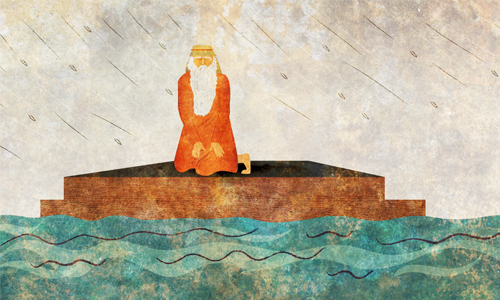
Enosh (not to be confused with Enoch) was born in the year 235 from creation (3526 BCE).1 His father’s name was Seth, the third son of Adam and Eve. He was given the name Enosh, which means “person” or “people,” because it was around that time that the world began to be more heavily inhabited by people.2 He lived a total of 905 years, and died in the year 1140 from creation (2621 BCE).3
Torah Record
There is very little mention made of Enosh in the Torah, and most of what we know about him and his times is from Midrashic and Talmudic sources.
Here’s what the Torah itself has to say about Enosh. Mind you, the description is rather ambiguous and leaves a lot of room for interpretation.
“And to Seth also a son was born, and he named him Enosh; then huchal to call by the name of the L‑rd.”4
Note that the word huchal has been left untranslated. That was done deliberately, because it is not entirely clear what the word means. Many different interpretations have been offered; naturally, the Torah narrative will vary based on the different interpretations.
These are a number of commentaries offered on this verse:
Rashi: Huchal comes from the Hebrew word chol, which means “profaned.”
“Then it became profaned to call by the name of the L‑rd.”
In the times of Enosh, people began associating the name of G‑d with things other than G‑d, namely idols and other people (more on this later). As a result, the name of G‑d became profaned.
Ibn Ezra: Huchal comes from the Hebrew word hischil, which means “to begin.”
“Then people began to call in the name of the L‑rd.”
It was in the times of Enosh that people began engaging in the practice of prayer, calling out to the name of G‑d.
Previously, people did not believe that prayer was effective; if G‑d had made up His mind, there was no way that it could change. This changed in the times of Enosh, and people began to pray to G‑d.5
Sforno: While huchal means begin, it has a negative connotation.
“Then (the righteous) began to preach in the name of the L‑rd.”
Until the times of Enosh, there was no need to preach about G‑d; everyone was already aware of His presence and power. It was in his times that this knowledge diminished, and it became necessary for those in the know to preach about His existence.
That’s it as far as the Torah record goes. From here on is the Midrashic tradition.
The Roots of Idolatry
Although the straight reading of the verse is open to interpretation, the Midrashic tradition is pretty emphatic: Idolatry began in the times of Enosh.
Maimonides, in his introduction to the laws concerning idolatry, details the history of idolatrous thought and practise:
During the times of Enosh, mankind made a great mistake, and the wise men of that generation gave thoughtless counsel. Enosh himself was one of those who erred.6
Their mistake was as follows: They said that G‑d created stars and spheres with which to control the world. He placed them on high and treated them with honor, making them servants who minister before Him. Accordingly, it is fitting to praise and glorify them and to treat them with honor. [They perceived] this to be the will of G‑d, Blessed be He, that they magnify and honor those whom He magnified and honored, just as a king desires that the servants who stand before him be honored. Indeed, doing so is an expression of honor to the king.
After conceiving of this notion, they began to construct temples to the stars and offer sacrifices to them. They would praise and glorify them with words, and prostrate themselves before them, because by doing so they would—according to their false conception—be fulfilling the will of G‑d.
This was the essence of the worship of false gods, and this was the rationale of those who worshipped them. They would not say that there is no other god except for this star.7
Ironically, idolatry originally had holy intentions; people thought that such practices were actually honoring G‑d. Maimonides continues to describe how these mistakes led to all-out idol worship, and how the existence of G‑d was completely forgotten from the earth, save for a few righteous individuals.
Was Enosh himself a part of this movement, or was it merely the people of his times?
Although Maimonides says he was, other commentators disagree. They cite the following Midrash to support their claim:
Until this point (the birth of Adam, Seth and Enosh), man was created in the image and form of G‑d. From this point on, the generations became corrupt and were created deformed.8
It seems from this Midrash that Enosh himself was one of the good ones, ranking with Adam and Seth.9
More on His Era
There are scattered references in Midrashic sources which give us a glimpse into the goings-on of the times.
Here’s one of the more fascinating accounts:
The generation of Enosh approached him and asked, “What is the name of your father?” to which he responded, “Seth.” “The name of your grandfather?” “Adam.” “And what was Adam’s father’s name?” they asked. “He had no father,” Enosh explained. “G‑d created his form from the earth and then blew into his nostrils a living soul.”
They said to Enosh, “Demonstrate how it was done.”
Enosh then took a handful of dirt and formed the image of a man, and the evil spirit entered into his nostrils and he became alive. The people declared this being as their god, and they believed in it.10
Aside for clearly portraying Enosh as the ringleader, this Midrash gives us insight into the extent to which their practices and beliefs went. They created an outright golem, which they viewed and treated as a god!
The results of their actions were forthcoming. The Midrash relates:
Four things changed in the times of Enosh: (a) the mountains became rocky, (b) the deceased began to rot, (c) people’s faces became similar to those of apes, and (d) people became susceptible to demons.”11
Witchcraft and sorcery became widespread as well in his times.12 We are told that even young children were well trained in occult practices, and that when the time came for Noah’s flood, the people did not heed Noah’s warnings because of the trust they had in their magical powers.13
The Not-So-Well-Known Great Flood
Most people are aware of the Great Flood that took place in the times of Noah, in the year 1656 from creation (2016 BCE). That wasn’t the first Great Flood in history; it was preceded by a Pretty-Great Flood in the times of Enosh.
As a punishment for the sins of the generation, G‑d had the sea overflow and flood a third of the inhabited world.14 The Midrash sees this punishment as being tit-for-tat, in direct response to their idolatrous behavior:
You have made a new creation and have called it by My name; I too will create something new (the floodwaters) and call it by My name. This is the meaning of the verse (Amos 5:8), “He Who calls the water of the sea and pours it out on the face of the earth, the L‑rd is His Name.”15
How big was this flood? A number of opinions are recorded, all in the name of R. Chanina:
R. Yudan, R. Abahu and R. Elazar received from R. Chanina: until Acco and Jaffa;
R. Chaninah and R. Acha received from R. Chanina: until the Barbary Coast;
R. Elazar received from R. Chanina: until Calabria.16
This drastic event did not do much to hinder the advances of the idolatry movement, and the world continued in steady decline. Terrible famine is said to have spread in those times, as the earth became less and less fertile as a punishment for their sins.17 (It wasn’t until the times of Noah, who was born in the year 1056 from creation (2705 BCE), that the plough was first invented, which significantly eased the farming process.18)
In summary, the times of Enosh are not depicted in the most positive of lights, and Enosh himself is seen as being the catalyst for these negative developments.
Shaul Wolf was born and raised in Melbourne, Australia. He studied in Yeshiva Ohr Elchonon in Los Angeles and received his rabbinical ordination from the Central Chabad Yeshivah in Brooklyn, N.Y. He currently lives in Brooklyn where he studies and responds to questions for Ask the Rabbi @ Chabad.org.
FOOTNOTES
1. Adam fathered Seth at the age of 130 (Genesis 5:3), and Seth was 105 when he had Enosh (Genesis 5:6), totaling 235.
2. Sefer HaYashar.
3. Genesis 5:11.
4. Genesis 4:26.
5. Radak adds this explanation in his commentary on this verse. He also offers the reading “Then people began to call (to other things, such as idols) in the name of the L‑rd,” which concurs with the view cited above, that this verse is to read as casting a negative light on those times.
6. Maimonides asserts that Enosh himself was one of the idolaters. We’ll address this later on in the article.
7. Mishneh Torah, Laws of Idolatry and its Statutes 1:1.
8. Genesis Rabbah 23:9. See Abarbanel, who cites this Midrash in opposition to the view of Maimonides.
9. The following statement from the Talmud is brought as Maimonides’s source:
“R. Chiya bar Abba said in R. Yochanan’s name: One who observes the Shabbat according to its laws, even if he practices idolatry like the generation of Enosh, he is forgiven” (Shabbat 118b).
This statement is quoted by Tur (Orach Chaim 242:1) with a slight variation: “Even if he practices idolatry like Enosh, he is forgiven.” It is suggested that Maimonides had a similar reading in his version of the Talmud, which incriminates Enosh together with the people of his times.
10. Midrash cited in the commentary of Rosh.
11. Genesis Rabbah 23:6.
12. Yalkut Reuveni presents another fascinating episode from those times:
“What was their sin? They traveled from one end of the world to the other and gathered gold, silver and other precious jewels and stones, which they formed into an idol the size of 1,000 square parsah. They would then draw down the sun, moon, stars and constellations in order to serve them, just as they would have served G‑d.
How were they able to do this? (The fallen angels) Shamchazai and Azael taught them all kinds of witchcraft. It was at that point that the angels cried to G‑d, “What is man (Enosh) that You should remember him?” (Psalms 8:5)
13. Zohar 1:56a.
14. Mechilta, Yitro 6; Genesis Rabbah 23:11.
15. Genesis Rabbah ibid.
16. Ibid.
17. Sefer HaYashar.
18. Rashi, Genesis 5:29.
© Copyright 2015, all rights reserved.
Your Questions
Why Do Jewish Brides Wear White? By Yehuda Shurpin
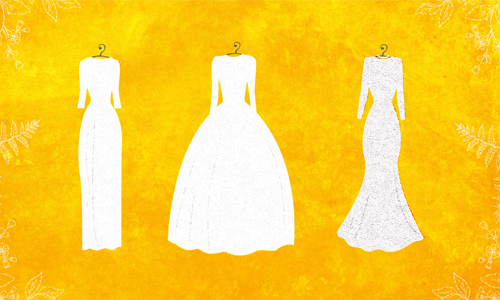
Question:
I always thought that that the idea of a bride wearing white was an ancient Jewish custom related to virginity and purity. However, I recently read an article on the Internet that said that this tradition actually originated with Queen Victoria in the mid-19th century. If this is so, why are Jews so keen on the white dress?
Reply:
Like many things you read on the Internet, this assertion needs to be taken with more than just a few grains of salt. Let’s clear up some misconceptions regarding wearing white at a Jewish wedding.
This custom predates Queen Victoria by at least 500 years. Rabbi Aaron ben Jacob ha-Kohen, who lived through the expulsion of the Jews from France in 1306, writes in in his famous work Orchot Chaim that the custom is to cover both the bride and groom in white.1 We also find that Rabbi David ibn Zimra, known as the Radbaz (b. 1479), cites an “ancient custom” within the Egyptian Jewish community for both the bride and groom to wear white at the wedding.2
Note that the custom is not just for the bride to wear white. Indeed, the groom traditionally wears a white kittel (robe) or tallit during the marriage ceremony.3 According to some sources, the groom’s white clothing is the primary custom,4 or even the only custom.5
However, it is usually more noticeable that the bride is wearing white, since some have the custom for a groom to wear a coat over the kittel.6
The Reasons
Now that we’ve established that wearing white at weddings has a long history, let’s examine the reasons for this custom:
Preparing for the Future
The Orchot Chaim says that the reason for wearing white at the wedding is based on the juxtaposition of two verses in Ecclesiastes: “At all times, let your garments be white . . .” and “Enjoy life with the wife whom you love.”7 8
What do white garments have to do with enjoying life with a new wife?
The sages say that white garments, clean and fit for a banquet, are like the good deeds we do here on earth, with which we will go to the ultimate banquet in the world to come.9 So when establishing our new Jewish home, we are reminded of the most important component: good deeds. The furniture and silverware and joint bank accounts will remain in this world, but our good deeds will stay with us into the next world.
A Personal Yom Kippur
Our sages tell us that one’s wedding day is considered like a personal Yom Kippur, when his or her sins are forgiven.10 Based on the verse “If your sins prove to be like crimson, they will become white as snow,”11 we wear white to show that our sins are being forgiven, just like on Yom Kippur.12
Wearing Shrouds to a Wedding
On a related note, some explain that the reason for wearing white is to remind us of burial shrouds. Bearing in mind that the wedding is a personal Yom Kippur, we wear white shroud-like garments to remind us of our eventual death and to arouse us to repentance.13
Together Until the End
Noting the resemblance to white burial shrouds, some explain that we wear white as a good omen that the couple will remain together until death.14
Back to Queen Victoria
Even though the Jewish custom of wearing white predates the Victorian era, there is one way that Queen Victoria did affect the custom: some brides are now careful not to wear a pure white dress to their wedding, lest it resemble too closely what has now become a non-Jewish custom, and instead wear an off-white dress.15
So the next time you see a bride wearing white, think of Yom Kippur, the world to come, and the grand chain of Jewish tradition that will remain unbroken for the rest of time.
Rabbi Yehuda Shurpin responds to questions for Chabad.org's Ask the Rabbi service.
FOOTNOTES
1. Orchot Chaim, Hilchot Kiddushin 21; see also Responsa of Maharam Mintz 109.
2. Responsa of Radbaz 2:693.
3. See Rabbi Moshe ben Avraham (1550–1606), Mateh Moshe, Hilchot Hachnasat Kallah 2.
4. Ibid.
5. Likkutei Maharich, vol. 3, Seder Nisuin.
6. Shaarei Halachah u-Minhag, Even ha-Ezer, p. 118; Responsa Naharei Afarsemon, Yoreh De’ah 22.
7. Ecclesiastes 9:8–9.
8. Orchot Chaim, Hilchot Kiddushin 21.
9. Talmud, Shabbat 153a, cited in Rashi, Ecclesiastes 9:8.
10. Talmud, Yevamot 63b.
11. Isaiah 1:18.
12. Mateh Moshe, Hilchot Hachnasat Kallah 2; Divrei David 1.
13. Responsa of Maharam Mintz 109; Likkutei Maharich vol. 3, Seder Nisuin.
14. Responsa Naharei Afarsemon, Yoreh De’ah 26.
15. See Nit’ei Gavriel, Hilchot Nisuin, vol. 1, p. 114, fn. #4.
© Copyright 2015, all rights reserved.VIDEO

Gas Stations, Greeks, and the Eternal Soul
True dedication is an old-school value that’s hard to find nowadays. It’s the ability to overlook yourself and become completely dedicated to the needs of another. Chanukah means “dedication,” and its story teaches us the secret of Jewish dedication.
By Aryeh Weinstein
 Watch (5:39)
Watch (5:39)<script language="javascript" type="text/javascript" src="http://embed.chabad.org/multimedia/mediaplayer/embedded/embed.js.asp?aid=3101645&width=auto&height=auto"></script><span style="clear:both;" class="lb" id="lbdiv">Visit <a href="http://www.chabad.org/multimedia/default_cdo/aid/591213/jewish/Video.htm">Jewish.TV</a> for more <a href="http://www.chabad.org/multimedia/default_cdo/aid/591213/jewish/Video.htm">Jewish videos</a>.</span>
More in Video:
• What Makes a Marriage Endure?
http://www.chabad.org/therebbe/livingtorah/player_cdo/aid/2660933/jewish/What-Makes-a-Marriage-Endure.htm
http://www.chabad.org/2660933
• A Kabbalistic Spin on Dreidel (Aaron L. Raskin)
<script language="javascript" type="text/javascript" src="http://embed.chabad.org/multimedia/mediaplayer/embedded/embed.js.asp?aid=2807235&width=auto&height=auto"></script><span style="clear:both;" class="lb" id="lbdiv">Visit <a href="http://www.chabad.org/multimedia/default_cdo/aid/591213/jewish/Video.htm">Jewish.TV</a> for more <a href="http://www.chabad.org/multimedia/default_cdo/aid/591213/jewish/Video.htm">Jewish videos</a>.</span>
---------------------Story
The Monster in the Woods By Eli Landes
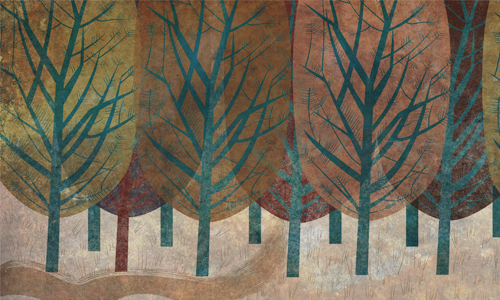
Somewhere in Russia, mid-19th century . . .
I trudge slowly through the dark forest, huddled deep in my coat in vain pursuit of its meager protection. The heavy rain and howling winds slam into me, threatening to toss me from the dirt path and worming the cold insidiously into my bones. I stumble on, squinting through the dark to see the dim path ahead of me, wishing I was home, wishing I was anywhere but here.
Here to visit the Monster of the Woods.I trudge slowly through the dark forest
As I near my destination, I become less and less aware of the rain and wind, their importance paling beside the fear bubbling inside me. I’ve grown up on tales of the Monster of the Woods, of his evilness, of the horrors that befall those who anger him. It’s madness to willingly go to him, but I have no choice. I need his help.
After what seems like an eternity, I reach a small clearing. A tiny hut stands in the middle of it, barely visible in the gloom. Soaked to the bone with rain and exhaustion, I walk to the hut, my legs propelling me forward. As I near, I start to hear the thump-thump-thumping of my heart, its steady beat carrying over the shriek of the winds. I can taste my dread, sick and acrid against my tongue, and my hands tremble with fright.
Then, almost without realizing it, I find myself by the door.
I take a breath—a shaking, shuddering breath—and raise my hand to knock.
I have to knock a few times, hard and loud, before I hear movement in the hut. There is the creak of a chair, the sound of something—a pot, maybe?—crashing to the ground, and then footsteps slowly approaching the door. With a dry groan, the door swings open.
The old Jew peers up at me, squinting against the rain that swirls around me. He is bent and grizzled, this Monster of the Woods, but I can see that his eyes are bright, cunning and shrewd, reflecting the evil of his race.
“Yes? Can I help you?”
I swallow. I need this Jew, need what he knows, but I am still afraid, and my words tumble over each other, coming out wrong and befuddled. “Medicine. I need medicine. I mean, my father does. He’s sick, you see, and the doctors don’t know how to help him. And you do. That is, I heard that you know medicines—herbs and such? And that I can describe the illness to you and you can cure it? I have money, too. To pay. For the medicine.”
The Jew nods. “Well. You’d better come in, then.” He turns around and enters his home.
I swallow. I don’t want to enter the Monster’s house—a thousand stories detail the folly in such an action—but what can I do? He's already walked into his house. Plus, I’m cold, so cold I’ve forgotten what warm feels like, and in the corner of the hut I can see a fire.
Sighing, I enter, shrugging out of my coat and laying it over a stool. I hurry over to the fire, crouching low and letting out a satisfied sigh as its heat spreads over me. The Jew walks over and hands me a cup of hot water, which I slowly sip.
He sits down on a stool across from me. “So. Start from the beginning. Describe your father’s illness.”
I do, having made sure to memorize every detail of it. When I’m done, the Jew cocks his head and looks at me inquisitively.
“You’re Boris, right? Igor’s son?”
I feel a stab of terror pierce my heart. “What of it?” I slowly bend my knees, so I can jump up if I have to run.
“What of it?” The Jew shrugs. “Nothing. I remember you, is all. I used to live in the town, years ago. Before they realized the gold mine in their midst—before they realized that they could blame any vices they have on the ‘evil Jews’ and avoid having to take responsibility for them. Anyway, back then, I used to see you around, sometimes. You’re taller now, but I recognize you.”
For the first time, my fear is overpowered by my anger. “Oh, that’s clever. Pretending that you’re the victim. I know what you are; everyone does. You’re the Monster of the Woods.”
The Jews smiles, an odd, sad smile, and for a moment I catch a glimpse of an immeasurable grief and pain in that smile. “Ah, yes. How could I forget? I am the terrible Monster, tricking his visitors and stealing their wealth.” He spreads his arms wide. “Can you not see it—the gold and silver lining my walls? This beautiful throne of diamonds I sit on? Look how majestically I live. Yes, I must be a terrible bandit—a monster, indeed.”
“Well, of course you don’t show it. If you lived in splendor, you wouldn’t be able to rob people. You need to appear poor to get them off their guard. When I leave, I'm sure you’ll revert to your true form.”
“Ah, yes. That is clearly the most logical explanation.” He applauds, slowly. “Well done, Boris, son of Igor. You have seen to the heart of my nature.”
I scowl, at him, angry at being mocked, and open my mouth to argue. Before I can speak, he wearily raises a hand. “No, don’t. I’m not interested in arguing with you.” He stands, walks to a trunk by the wall and starts pulling out herbs. As he sorts through them, he speaks over his shoulder. “Do you know why they call me a monster? It’s not because I’m dangerous or particularly frightening. No, I’m a monster because I’m something far worse. I’m different.”
He turns from the wall and walks towards me with a satchel. “Here—the medicine for your father. I’ve included instructions as to how he should take them. If he follows them, he should heal properly.”
I take them wordlessly and stand to leave. “Do you know why they call me a monster?”As I reach the door, I turn back to face him. “If it’s so hard for you, why don’t you be like everyone else?”
The odd Monster smiled. “How was the trek on the way here?”
“Difficult. I could barely see the path, and the winds kept trying to blow me off the path into the woods.”
He nodded. “You could have just walked off into the forest. Abandoned the path, stopped struggling through the winds and given up. The trees would have sheltered you; you would have had no need for light without a path. But you didn’t. Because you’d never have found your way here without the path to guide you.
“I could give it up. Live in the forest, be comfortable in this world. But then I’d have to give up my path, my difficult path through the forest. And what would be the point, then? What’s the point of entering the forest if you won’t walk the right path?”
Eli Landes was ordained as a rabbi in South Africa, and is working to complete his Bachelor of Arts. Currently residing in Brooklyn, N.Y., he enjoys blending the esoteric depths of Chassidus with the creativity of writing.
© Copyright 2015, all rights reserved.
Story
The Cat
By Yanki Tauber

The sixth Lubavitcher Rebbe, Rabbi Yosef Yitzchak Schneersohn, was once challenged: “Tell me, Rebbe, how can you, in this day and age, still insist that the Torah is the unadulterated word of G‑d? Are you not the least bit swayed by the fact that so many Bible critics and men of science reject your beliefs?”
The rebbe responded with a story:
A young aspiring inventor labored for many years on a project. Finally, he wrote to his mentor, a great engineer under whose tutelage he had studied, saying that he wished to present his efforts for his teacher’s critique. The great engineer replied that he was scheduled to be in the young man’s hometown in a few weeks, and that he would be more than happy to drop by and offer his comments on his beloved student’s invention.
As the appointed day neared, the young man grew extremely agitated. He felt that this was to be the most important test of his career. He saw this invention as the embodiment of his most creative ideas; his mentor’s opinion of it would be the ultimate assessment of his worth.
When he woke that morning, he knew that he could not trust himself to face his mentor’s verdict. He left his blueprint on the table of his study, together with a note in which he begged forgiveness for his absence and asked his teacher to please put his comments in writing. After telling his wife to direct the engineer to the study, he left the house to pace the streets.
It was late in the evening when he re-entered his study. No sooner did his glance fall on the table than he uttered a small cry and collapsed in his chair. His wife, rushing to her husband’s side, found him white as a sheet and with a look of utter despair in his eyes. On the table lay the blueprint of his invention, with a few terse lines of black ink crisscrossing it from corner to corner.
“It does look like it’s in bad shape,” said his wife. “But can’t you redraw it from memory?”
“Draw it from memory? Every line on that diagram is ingrained in my mind. I can draw it in my sleep. But that is hardly the problem, is it?”
“What then is the problem?” wondered the good woman.
“The problem is that the greatest engineer in the land has crossed out the last ten years of my life!”
“Your teacher?” said the inventor’s wife. “He sent word that he can’t come today. What happened was that the cat climbed onto your table and knocked over a bottle of ink.”
© Copyright 2015, all rights reserved.
Parshah
Feeling the Fear By Rabbi Jonathan Sacks
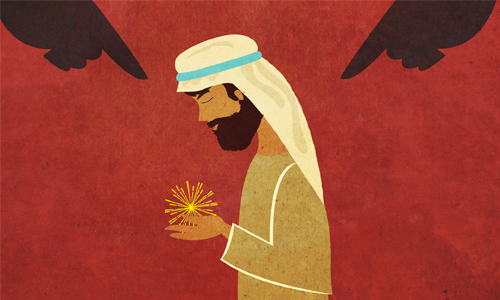
It is one of the most enigmatic episodes in the Torah, but also one of the most important, because it was the moment that gave the Jewish people its name: Israel, one who “wrestles with G‑d and with men, and prevails.”
Jacob, hearing that his brother Esau is coming to meet him with a force of four hundred men, was terrified. He was, says the Torah, “very afraid and distressed.” He made three forms of preparation: appeasement, prayer and war.1 He sent Esau a huge gift of cattle and flocks, hoping thereby to appease him. He prayed to G‑d, “Rescue me, I pray, from the hand He sent Esau a huge giftof my brother.”2 And he made preparation for war, dividing his household into two camps so that one at least would survive.
Yet he remained anxious. Alone at night, he wrestled with a stranger until the break of dawn. Who the stranger was is not clear. The text calls him a man. Hosea called him an angel.3 The sages said it was the guardian angel of Esau.4 Jacob himself seems sure that he has encountered G‑d himself. He calls the location where the struggle took place Peniel, saying, “I have seen G‑d face to face, and my life was spared.”5
There are many interpretations. One, however, is particularly fascinating in terms of both style and substance. It comes from Rashi’s grandson, Rabbi Shmuel ben Meir (Rashbam; France, c. 1085–1158). Rashbam had a strikingly original approach to biblical commentary.6 He felt that the sages, intent as they were on reading the text for its halachic ramifications, often failed to penetrate to what he called omek peshuto shel mikra, the plain sense of the text in its full depth.
Rashbam felt that his grandfather occasionally erred on the side of a midrashic, rather than a “plain,” reading of the text. He tells us that he often debated the point with Rashi himself, who admitted that if he had the time he would have written further commentaries to the Torah in the light of new insights into the plain sense that occur to him “every day.” This is a fascinating insight into the mind of Rashi, the greatest and most famous commentator in the entire history of rabbinic scholarship.
All of this is a prelude to Rashbam’s remarkable reading of the nighttime wrestling match. He takes it as an instance of what Robert Alter has called a type-scene,7 that is, a stylized episode that happens more than once in Tanach. One obvious example is young-man-meets-future-wife-at-well, a scene enacted with variations three times in the Torah: in the case of Abraham’s servant and Rebecca, Jacob and Rachel, and Moses and Tzipporah. There are differences between them, but sufficient similarities to make us realize that we are dealing with a convention. Another example, which occurs many times in Tanach, is birth-of-a-hero-to-a-hitherto-infertile-woman.
Rashbam sees this as the clue to understanding Jacob’s nighttime fight. He relates it to other episodes in Tanach, two in particular: the story of Jonah, and the obscure episode in the life of Moses when, on his way back to Egypt, the text says that “when they were in the place where they spent the night along the way, G‑d confronted Moses and wanted to kill him.”8 Tzipporah then saved Moses’ life by giving their son a brit.9 10
It is the story of Jonah that provides the key to understanding the others. Jonah sought to escape from his mission to go to Nineveh to warn the people that the city was about to be destroyed if they did not repent. Jonah fled in a boat to Tarshish, but G‑d brought a storm that threatened to sink the ship. The prophet was then thrown into the sea and swallowed by a giant fish that later vomited him out alive. Jonah thus realized that flight was impossible.
The same, says Rashbam, applies to Moses, who at the burning bush repeatedly expressed his reluctance to undertake the task G‑d had set him. Evidently, Moses was still prevaricating even after beginning the journey, which is why G‑d was angry with him.
So it was with Jacob. According to Rashbam, despite G‑d’s assurances, he was still afraid of encountering Esau. His courage failed him and he was trying to run away. G‑d sent an angel to stop him from doing so.
It is a unique He was still afraid of encountering Esauinterpretation, sobering in its implications. Here were three great men, Jacob, Moses and Jonah, yet all three, according to Rashbam, were afraid. Of what? None was a coward.
They were afraid, essentially, of their mission. Moses kept telling G‑d at the burning bush: Who am I? They won’t believe in me. I am not a man of words. Jonah was reluctant to deliver a message from G‑d to Israel’s enemies. And Jacob had just said to G‑d, “I am unworthy of all the kindness and faith that You have shown me.”11
Nor were these the only people in Tanach who had this kind of fear. So did the prophet Isaiah when he said to G‑d, “I am a man of unclean lips.” So did Jeremiah when he said, “I cannot speak: I am a child.”
This is not physical fear. It is the fear that comes from a feeling of personal inadequacy. “Who am I to lead the Jewish people?” asked Moses. “Who am I to deliver the word of G‑d?” asked the prophets. “Who am I to stand before my brother Esau, knowing that I will continue the covenant and he will not?” asked Jacob. Sometimes the greatest have the least self-confidence, because they know how immense is the responsibility and how small they feel in relation to it. Courage does not mean having no fear. It means having fear but overcoming it. If that is true of physical courage, it is no less true of moral and spiritual courage.
Marianne Williamson’s remarks on the subject have become justly famous. She wrote:
Our deepest fear is not that we are inadequate. Our deepest fear is that we are powerful beyond measure. It is our light, not our darkness that most frightens us. We ask ourselves, Who am I to be brilliant, gorgeous, talented, fabulous? Actually, who are you not to be? You are a child of G‑d. Your playing small does not serve the world. There is nothing enlightened about shrinking so that other people won’t feel insecure around you. We are all meant to shine, as children do. We were born to make manifest the glory of G‑d that is within us. It’s not just in some of us; it’s in everyone. And as we let our own light shine, we unconsciously give other people permission to do the same. As we are liberated from our own fear, our presence automatically liberates others.12
Shakespeare said it best (in Twelfth Night): “Be not afraid of greatness: some are born great, some achieve greatness, and some have greatness thrust upon ’em.”
I sometimes feel that, consciously or subconsciously, some take flight from Judaism for this very reason. Who are we to be G‑d’s witness to the world, a light to the nations, a role model for others? If even spiritual giants like Jacob, Moses and Jonah sought to flee, how much more so you and me? This fear of unworthiness is one that surely most of us have had at some time or other.
The reason it is wrong is not that it is untrue, but that it is irrelevant. Of course we feel inadequate to a great task before we undertake it. It is having the courage to undertake it that makes us great. Leaders grow by leading. Writers grow by writing. Teachers grow by teaching. It is only by overcoming our sense of inadequacy that we throw ourselves into the task and find ourselves lifted and enlarged by so doing. In the title of a well-known book, we must “feel the fear and do it anyway.”
Be not afraid of greatness: that is why G‑d wrestled with Jacob, Moses and Jonah, and would not let them escape. We may not be born great, but by being born (or converting to become) a Jew, we have Have the courage to be differentgreatness thrust upon us. And as Marianne Williamson rightly said, by liberating ourselves from fear, we help liberate others. That is what we as Jews are meant to do: to have the courage to be different, to challenge the idols of the age, to be true to our faith while seeking to be a blessing to others regardless of their faith.
For we are all children of the man who was given the name of one who wrestles with G‑d and with men and prevails. Ours is not an easy task, but what worthwhile mission ever was? We are as great as the challenges we have the courage to undertake. And if at times we feel like running away, we should not feel bad about it. So did the greatest.
To feel fear is fine. To give way to it is not. For G‑d has faith in us, even if at times even the best lack faith in themselves.
Rabbi Jonathan Sacks is the former Chief Rabbi of Great Britain and the British Commonwealth. To read more writings and teachings by Lord Rabbi Jonathan Sacks, or to join his e‑mail list, please visitwww.rabbisacks.org.
FOOTNOTES
1. Rashi, Genesis 32:9.
2. Genesis 32:12.
3. Hosea 12:4.
4. Bereishit Rabbah 77:3.
5. Genesis 32:30.
6. He sets this out in his commentary to Genesis 37:2.
7. See Robert Alter, The Art of Biblical Narrative.
8. Exodus 4:24.
9. Exodus 4:25–26.
10. Rashbam, Genesis 32:29. Rashbam also includes the episode of Balaam, the donkey and the angel as a further instance of this type-scene.
11. Genesis 32:11.
12. Marianne Williamson, A Return to Love (HarperCollins, 1992), 190.
© Copyright 2015, all rights reserved.
Parshah
Dinah: The Woman Who Made a Difference
By Rochel Holzkenner

There is only one incident of sexual abuse that is recorded explicitly in the Torah. (Sarah was abducted by Pharaoh and again by Abimelech, but remained safely untouched in those kings’ palaces until she was liberated.) It is quite a tragic read, and the repercussions are curiously significant.
Jacob had twelve sons and one daughter, Dinah. As can be imagined, this daughter was well protected under the watchful eyes of her holy brothers. Sarah was abducted by Pharaoh and again by AbimelechFor many years Jacob lived in Charan and worked for his father-in-law, Laban. Eventually he decided to live independently from Laban, and he and his family packed up and traveled to the land of Canaan. In Canaan, they stopped in the city of Shechem with the thought of settling there. It was in Shechem that Jacob’s worst nightmare transpired.
Dinah, the daughter of Leah whom she bore to Jacob, went out to see the daughters of the land. Shechem, the son of Hamor the Hivite, prince of the land, saw her; and he abducted her, lay with her and afflicted her. (Genesis 34:1–2)
When Dinah left her family’s camp to meet the local women, she was abducted and raped by Shechem (a prince with the same name as the city). The Torah describes Shechem’s calculated steps: He saw her, he abducted her, he lay with her and he afflicted her. What is the difference between “lying with her” and “afflicting her”? Rashi quotes the Midrash and explains that he abused her in both a conventional way (“lying”) and an unconventional way (“affliction”). But perhaps the Torah is also describing the physical and emotional abuse that Dinah experienced with Shechem.
Any woman who has experienced sexual abuse understands the depth of affliction unleashed from one mere act of violation. It rips apart the very fabric of our feminine dignity, and it requires a lot of concentrated healing to restore our sense of self-respect. Dinah, a princess in the house of Jacob, was violated and afflicted.
In the beginning of this frightening story Dinah is introduced to us as the daughter of Leah, a fact that we already know. And the fact that Jacob is her father seems almost incidental: “Dinah, the daughter of Leah whom she bore to Jacob.” It sounds like her primary tie is to her mother. The Torah also gives us a context for her abduction: “[She] went out to see the daughters of the land.”
Rashi sees a significant connection between the description of Dinah as “the daughter of Leah” (and not Jacob) and the mention of her “going out to see the daughters of the land.” He explains:
Because of her going out, she is called “the daughter of Leah.” For [Leah], too, was an “outgoer,” as it is written, “Leah went out to greet him” (Genesis 30:16). Regarding her it was said, “Like mother, like daughter.”
How do you understand this Rashi? Is he suggesting that she was too outgoing, and that’s what got her into trouble? Is he somehow implicating Dinah in her own abduction?
But Rashi doesn’t just say she was outgoing; he says she was outgoing like her mother. When was Leah outgoing? Rashi highlights a particular incident to prove Leah’s extroversion: “Leah went out to greet him.” Leah’s son Reuben had found plants called dudaim in the field and brought them to his mother. Rachel asked her sister to give her the dudaim that Reuben had just brought her. It is possible that the dudaim had potent medicinal qualities that increased a woman’s fertility, and Rachel was eager to conceive a child. Leah agreed to give her the dudaim in exchange for the opportunity to spend the night with Jacob, a night that Jacob had reserved for Rachel. Rachel agreed. Now they needed to tell Jacob of their deal in the most tactful and honorable manner. Leah was the one who told him.
And this is the verse that Rashi quotes to display Leah’s outgoing nature: “When Jacob came from the field in the evening, Leah went out toward him, and she said, ‘You shall come to me, because I have hired you with my son’s dudaim’; and he slept with her on that night” (Genesis 30:16). She didn’t wait for him to come home and possibly feel rejected by Rachel. She walked out to meet him, and explained to him what she and Rachel had arranged before he arrived at home. She was proactive in her consideration of her husband.
And that night she conceived her fifth son: “G‑d hearkened to Leah, and she conceived She was proactive in her consideration of her husbandand bore Jacob a fifth son” (Genesis 30:17). Rashi takes note of the words “G‑d hearkened to Leah” and explains why G‑d was so impressed with her: “She desired and was seeking means to increase the number of tribes.”
She went out to Jacob not only to be considerate of his dignity, but also because she was eager for the opportunity to conceive another child and increase the number of the Israelite tribes. G‑d was so pleased with Leah’s action that He blessed her with another son.
Clearly, Leah was outgoing in the most noble way. To compare Dinah’s extroverted nature to Leah’s is a complimentary description of Dinah, and certainly not an implication of her guilt. “Like mother, like daughter!”
Dinah was “the daughter of Leah whom she bore to Jacob.” Why is her relationship with Jacob mentioned as a mere byproduct of her being her mother’s daughter? There is an interesting story that sheds light on this question.
When Jacob first left the land of Charan, he prepared to meet his wicked brother, Esau. We read that “[Jacob] took his two wives, his two handmaidens and his eleven sons, and he crossed the ford of the Jabbok” (Genesis 32:23). Rashi asks,
Where was Dinah? Jacob had placed her in a chest and locked her in, lest Esau set his eyes on her. For this Jacob was punished, for had he not withheld her from his brother, perhaps she would have brought Esau back to the proper path. [The punishment was] that she fell into the hands of Shechem.
When it comes to the story of Dinah’s abduction, Jacob is mentioned minimally, because he precipitated her misfortune by insulating her before he met his brother. Now, it’s completely understandable that Jacob didn’t want his pure and beautiful daughter to marry his evil brother. He would have had to be crazy to marry her off to Esau. In fact, the Talmud tells us that Leah herself averted her original fate of marrying Esau through her prayers:
Because she expected to fall into Esau’s lot, she wept. Because everyone was saying, “Rebecca has two sons, and Laban has two daughters. The older [daughter] for the older [son], and the younger [daughter] for the younger [son].” (Talmud, Bava Batra 123a)
And yet we don’t find Leah punished for her prayers.
What is quite evident from this story is that Dinah in all probability would have influenced Esau to live an upstanding life. If not, why would Jacob have been so criticized for robbing Esau of this opportunity? Perhaps Leah accurately assessed her capabilities and knew that she wouldn’t have been able to influence him, and therefore there was no negative consequence to her prayers.
But Dinah was different. She was even more outgoing and efficacious than her mother. G‑d was disappointed that she didn’t have the opportunity to work her magic on Esau.
Both her positive, outgoing nature and her potential to influence one of the most corrupt men of her time are contained in the phrase that introduces us to her terrible encounter with Shechem: “Dinah, the daughter of Leah whom she bore to Jacob, went out to see the daughters of the land.”
Dinah, like her mother, was an outgoing and charismatic girl. It was only natural that after her family set up shop in the village of Shechem, she ventured out to see “the daughters of the land.” Perhaps she wanted to enlighten them about the monotheistic beliefs that her father and grandfather had been propagating throughout the Middle East. Unfortunately, she was badly hurt in the process.
And yet, despite the abuse that she endured, she still managed to profoundly impact her environment. Shechem himself seemed to be transformed by his short encounter with her. Shechem was a spoiled prince and a vile rapist. Shechem had no respect for women; he used them and disposed of them. And yet, after he was intimate with her, he began to develop tender feelings toward her:
His soul cleaved to Dinah, the daughter of Jacob; he loved the girl and spoke to the girl’s heart. And Shechem spoke to his father, Hamor, saying, “Take this girl for me as a wife.” (Genesis 34:3–4)
Why did he feel so connected to her? How could he have loved her? What did he say to her? Perhaps he was apologizing for what he had done, and was trying to win her approval. Instead of using her and trashing her, he suddenly wanted to marry her, and humbly sought Why did he feel so connected to her? How could he have loved her?the consent of her father, Jacob. In fact, he was willing to pay top dollar just to have Dinah’s hand in marriage:
Hamor spoke with them, saying: “My son, Shechem, his soul has a liking for your daughter. Please give her to him for a wife. . . . Shechem said to her father and to her brothers, “May I find favor in your eyes. Whatever you tell me, I will give.” (Genesis 34:8–11)
Of course, Dinah would never consent to marry her abuser; but nonetheless, the shift in Shechem cannot be ignored.
Dinah’s brothers pretended to agree to Shechem’s request on the condition that Hamor (Shechem’s father), Shechem, and all of the people of their village circumcise themselves. Not only did Hamor and Shechem agree to this condition, but they persuaded all of the townsfolk to agree. At face value, this was all a ploy to weaken the inhabitants of the town so that the brothers could safely rescue Dinah. Yes, the circumcision was strategic, but it was also a rectification for the people of Shechem. Circumcision represents the mitigation of sexual impulsivity and self-centered lust. Perhaps it was through Shechem’s commitment to undergo a circumcision that he rectified his aggressive and dominant actions. The circumcision was also part of a conversion process to the Jewish religion. Both the men and the women willingly converted to Jacob’s monotheistic beliefs.
Yet, in the most zealous act of chivalry, two of Dinah’s brothers conspired not only to rescue Dinah, but to repay Shechem for the terrible travesty of violating their sister. Simeon and Levi decided to kill Shechem and all the men of the village, who had stood silently by while Shechem committed this injustice.
Jacob did not know that his sons had planned to mete out judgement on the whole town. When he found out they they had wiped out the entire city to avenge their sister’s violation, he rebuked them:
“You have troubled me, to discredit me among the inhabitants of the land, among the Canaanites and among the Perizzites. I am few in number, and they will gather against me, and I and my household will be destroyed.” (Genesis 34:30)
The story ends with the brothers’ response to Jacob. They ask him a rhetorical question that embodies the high price they were willing to pay for their sister’s protection: “Shall he make our sister like a harlot?”
And yet, amidst the tragic circumstances, Dinah still managed to be quite influential. She was a born leader, like her mother, outgoing and influential. The women of the town of Shechem retained a relationship with Dinah’s family. Both Dinah and Leah are praised for “going out.”
The Midrash (Yalkut Shimoni 134) tells us that Dinah conceived a child from her union with Shechem, a daughter named Asenath. Asenath eventually moved to Egypt and worked in the house of Potiphar. Joseph, who was already a viceroy to the king, met her and was impressed by her commitment to her faith, even in Egypt. He married Asenath (his niece), and they had two children together, Manasseh and Ephraim. Although these sons were born outside of the Holy Land and grew up in the lap of luxury, they were so spiritually centered that they surpassed even their cousins who were raised in Canaan. Jacob gave Joseph’s sons special treatment, blessing them in the same way that he blessed his sons. Eventually, Joseph’s sons merited to head their own tribes, something that was reserved for the sons of Jacob and not his grandchildren. It was Asenath, the daughter of Dinah and Shechem, who raised these two child prodigies all alone in Egypt.
Despite the pain that Dinah endured, the Torah prefaces the story with the message that Dinah, like Leah, was outgoing and influential. The Lubavitcher Rebbe, Rabbi Menachem Mendel Schneerson, of righteous memory, sees Dinah as the Torah’s first prototype of female leadership.
Sarah, Rebecca, Rachel and Leah were opinionated and decisive. On numerous occasions, they powerfully influenced their husbands and children. They were paradigms of the akeret habyit, the woman who builds her On numerous occasions, they powerfully influenced their husbands and childrenhome and lays the foundation for the next generation. But the Torah gives us no indication that they were influential outside of their home.1 Their lives were in sync with King David’s description of the Jewish woman, the daughter of the king: “The entire glory of the daughter of the king is her inwardness” (Psalms 45:13). She is glorified because of her inwardness—her first priority is her inner circle. This regal woman is dedicated to cultivating her marriage and investing in her children’s wellbeing. Like a true princess, her regality stems from her focus on what is important, not on what is popular. She doesn’t need to extend beyond her home life and promote herself publicly in order to validate her worth.
So, what would King David say about some of today’s “out there” women, many of whom are making a significant mark on society? Have they lost their opportunity for regal living?
Dinah was unique. She was gifted with a potent sphere of influence. Her charisma naturally attracted other people to take her lead. Dinah was drawn toward other women, and even in a new environment she was naturally social. Ultimately, she always influenced other people to become more spiritually sensitive.
Dinah is every woman who is naturally influential. For her, it would be a loss to hide in a box. She’s got her work cut out for her, and with conscious effort she can become an inspirational leader.
What about modesty? What about the inwardness that generates feminine glory? Yes, she has a higher calling for greater exposure, but at what personal cost? Does she have to relinquish the glory that comes from living a more private life?
The Rebbe advises female leaders to utilize their influence and still retain their modesty. That’s a difficult balance to maintain. Personal attention can become addictive. A more provocative way of dress and a flirtatious conversation can open doors for influential women. Modesty can feel like an unfair inhibition for female leaders.
But perhaps along with the loss of modesty comes the loss of focused influence: Does my exposure make people think more about G‑d, or more about me? A woman is most effective at making an inspirational mark on the world when she carries the allure of dignity. It’s an allure that modest dress and behavior naturally breeds. For her, King David’s “inwardness” doesn’t mean staying inside the house as much as it means staying true to herself. Modest leadership, in essence, is saying, “I have an authentic message to share, but I’m not prepared to compromise any boundaries to hook you in.” Instead, the female leader sets a tone of warmth and sincerity that speak for itself.
The Rebbe argues that the feminine model of leadership is even more effective than the typical masculine model of leadership, which tends to be more domineering and authoritarian. The feminine influence is predicated upon sincerity, selflessness and nurturing.
Rochel is a mother of four children and the co-director of Chabad of Las Olas, Fla., serving the community of young professionals. She is a high-school teacher and a freelance writer—and a frequent contributor to Chabad.org. She lectures extensively on topics of Kabbalah and feminism, and their application to everyday life. Rochel holds an MS in Brain Research from Nova SE University.
FOOTNOTES
1. The Midrash tells us that Abraham converted men to monotheism, and Sarah converted the women. The matriarchs did influence others outside their homes, but that they didn’t go out to influence; rather, they brought people into their homes to be influenced.
© Copyright 2015, all rights reserved.
From the Chabad.org Blog
Classic Chabad Manuscript Now Online in English
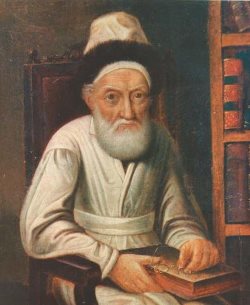
A painting of the Tzemach Tzedek (Library Of Agudas Chassidei Chabad)
Rabbi Menachem Mendel of Lubavitch passed away in the Jewish year 5626 (1866). Now, 150 years later, large portions of one of his most widely learned works, Derech Mitzvotecha, have been made available online in English for the very first time.
Known as the Tzemach Tzedek—the title of his monumental collection of response on Jewish law—he served as the third Chabad rebbe. He is credited for presiding over an era in which the Chassidic movement gained countless adherents, as well as acceptance and respect from a wide range of Jewish leaders.
Derech Mitzvotecha (“The Way of Your Commandments”) was one of his earliest works, penned between the years 1814 and 1828, when he was still a young man. It is a treatment of the Chassidic and Kabbalistic underpinnings of many of the Torah’s mitzvahs, such as belief in G‑d, tzitzit, tefillin, prayer, loving a fellow Jew, starting a family and others.
The work has a long and storied history.
It was first printed in Poltava, now in Ukraine, in the year 1911. Kehot Publication Society, the publishing arm of the Chabad-Lubavitch movement, reprinted it again in 1943, in Shanghai, China. It was done by a group of Chabad yeshivah students from Poland who had fled there via Japan to escape the Nazi onslaught.
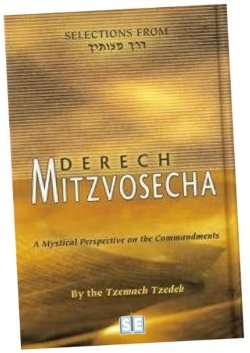
Selections of Derech Mitzvotecha were rendered by Rabbi Eliyahu Touger into English and published by Sichos in English in 2004.
It has since been reprinted many times in the United States and Israel by Kehot Publication Society.
Five generations after it was first written, the author’s great-great-grandson and successor, the Rebbe—Rabbi Menachem M. Schneerson, of righteous memory—often advised those seeking to begin study of Chassidic philosophy to study this fundamental work.
Rabbi Eliyahu Touger rendered selections of the work into English, and they were published by Sichos in English in 2004 with the permission of Kehot Publication Society. The new offering, titled Selections From Derech Mitzvosecha: A Mystical Perspective on the Commandments, Vol. 1, was quickly snapped up by English-speaking scholars everywhere, leaving the book currently out of print.
Touger’s translation is available online through a unique partnership between Sichos in English and Chabad.org.
View the online Derech Mitzvosecha here.
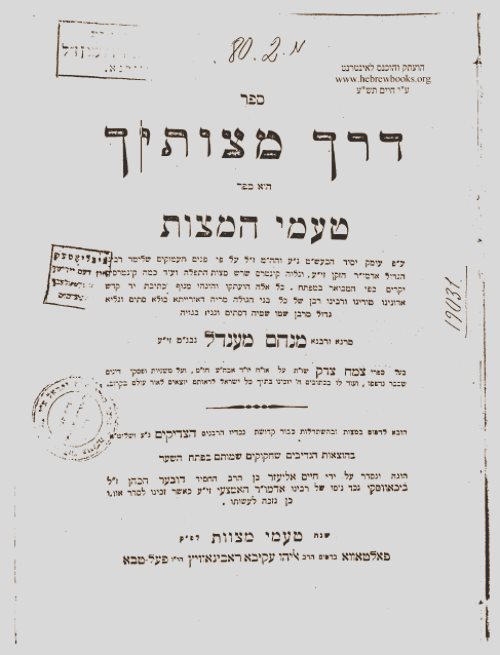
Derech Mitzvotecha was first printed in Poltava in 1911 (Library of the YIVO Institute for Jewish Research/HebrewBooks.org)
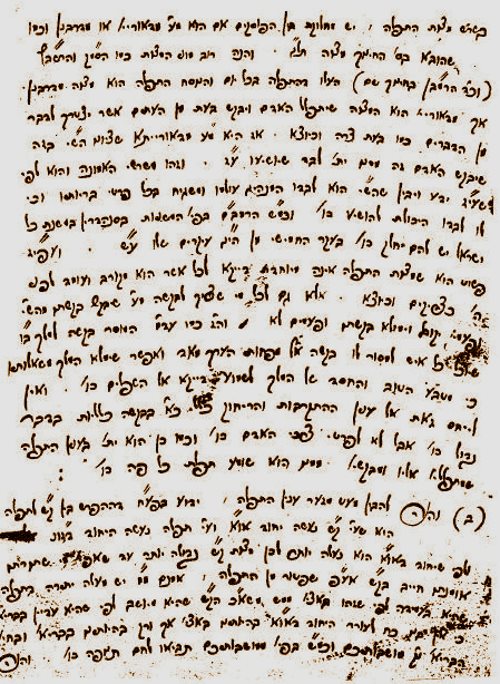
The original manuscript of Derech Mitzvotecha by the Tzemach Tzedek (Library Of Agudas Chassidei Chabad)
© Copyright 2015, all rights reserved.
From the Chabad.org Blog
Icing on Rabbi Kaplan’s Cake By Shmuel Lifshitz
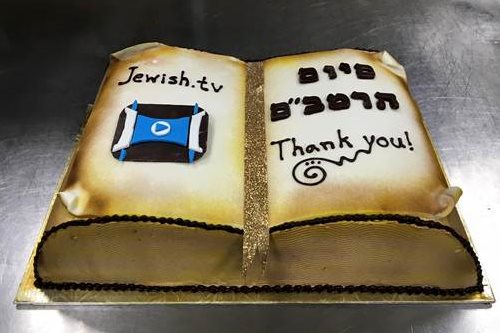
As Jewish communities around the globe marked the completion of the annual study of Maimonides’ Mishneh Torah, the folks at Chabad of Flamingo in Toronto had other reasons to celebrate.
For one thing, they have a great rabbi: Rabbi Mendel Kaplan, who seems to have an endless storehouse of wisdom and learning to share.
Also, many of them were completing the entire compendium of Jewish law known as the Mishneh Torah, or for others, the corresponding book called Sefer Hamitzvot (“Book of Commandments”).
But there was an added element of excitement.
For some time, Rabbi Kaplan had been filming daily classes in Sefer Hamitzvot and streaming them over Jewish.tv, enabling thousands of individuals around the globe to learn alongside him and his merry band of students.
A unique aspect of these classes—aside from the rabbi’s signature crisp delivery and humor—is the fact that he often ties the study in with insight and facts from the corresponding chapters in Mishneh Torah, giving the students a feel of what others are learning at the same time.
They finished the first cycle two years ago. Then it took an additional two years to fill in the gaps caused by Shabbat, holidays and travel, but there is now a complete set of classes on the entire Sefer Hamitzvotavailable online on Jewish.tv.
The group couldn’t hold back their excitement. The international crowd of e‑learners was also excited, as were our guys at Jewish.tv.
So excited that they surprised the rabbi with this exquisite cake.
Mazal tov!
• A Kabbalistic Spin on Dreidel (Aaron L. Raskin)
<script language="javascript" type="text/javascript" src="http://embed.chabad.org/multimedia/mediaplayer/embedded/embed.js.asp?aid=2807235&width=auto&height=auto"></script><span style="clear:both;" class="lb" id="lbdiv">Visit <a href="http://www.chabad.org/multimedia/default_cdo/aid/591213/jewish/Video.htm">Jewish.TV</a> for more <a href="http://www.chabad.org/multimedia/default_cdo/aid/591213/jewish/Video.htm">Jewish videos</a>.</span>
---------------------Story
The Monster in the Woods By Eli Landes

Somewhere in Russia, mid-19th century . . .
I trudge slowly through the dark forest, huddled deep in my coat in vain pursuit of its meager protection. The heavy rain and howling winds slam into me, threatening to toss me from the dirt path and worming the cold insidiously into my bones. I stumble on, squinting through the dark to see the dim path ahead of me, wishing I was home, wishing I was anywhere but here.
Here to visit the Monster of the Woods.I trudge slowly through the dark forest
As I near my destination, I become less and less aware of the rain and wind, their importance paling beside the fear bubbling inside me. I’ve grown up on tales of the Monster of the Woods, of his evilness, of the horrors that befall those who anger him. It’s madness to willingly go to him, but I have no choice. I need his help.
After what seems like an eternity, I reach a small clearing. A tiny hut stands in the middle of it, barely visible in the gloom. Soaked to the bone with rain and exhaustion, I walk to the hut, my legs propelling me forward. As I near, I start to hear the thump-thump-thumping of my heart, its steady beat carrying over the shriek of the winds. I can taste my dread, sick and acrid against my tongue, and my hands tremble with fright.
Then, almost without realizing it, I find myself by the door.
I take a breath—a shaking, shuddering breath—and raise my hand to knock.
I have to knock a few times, hard and loud, before I hear movement in the hut. There is the creak of a chair, the sound of something—a pot, maybe?—crashing to the ground, and then footsteps slowly approaching the door. With a dry groan, the door swings open.
The old Jew peers up at me, squinting against the rain that swirls around me. He is bent and grizzled, this Monster of the Woods, but I can see that his eyes are bright, cunning and shrewd, reflecting the evil of his race.
“Yes? Can I help you?”
I swallow. I need this Jew, need what he knows, but I am still afraid, and my words tumble over each other, coming out wrong and befuddled. “Medicine. I need medicine. I mean, my father does. He’s sick, you see, and the doctors don’t know how to help him. And you do. That is, I heard that you know medicines—herbs and such? And that I can describe the illness to you and you can cure it? I have money, too. To pay. For the medicine.”
The Jew nods. “Well. You’d better come in, then.” He turns around and enters his home.
I swallow. I don’t want to enter the Monster’s house—a thousand stories detail the folly in such an action—but what can I do? He's already walked into his house. Plus, I’m cold, so cold I’ve forgotten what warm feels like, and in the corner of the hut I can see a fire.
Sighing, I enter, shrugging out of my coat and laying it over a stool. I hurry over to the fire, crouching low and letting out a satisfied sigh as its heat spreads over me. The Jew walks over and hands me a cup of hot water, which I slowly sip.
He sits down on a stool across from me. “So. Start from the beginning. Describe your father’s illness.”
I do, having made sure to memorize every detail of it. When I’m done, the Jew cocks his head and looks at me inquisitively.
“You’re Boris, right? Igor’s son?”
I feel a stab of terror pierce my heart. “What of it?” I slowly bend my knees, so I can jump up if I have to run.
“What of it?” The Jew shrugs. “Nothing. I remember you, is all. I used to live in the town, years ago. Before they realized the gold mine in their midst—before they realized that they could blame any vices they have on the ‘evil Jews’ and avoid having to take responsibility for them. Anyway, back then, I used to see you around, sometimes. You’re taller now, but I recognize you.”
For the first time, my fear is overpowered by my anger. “Oh, that’s clever. Pretending that you’re the victim. I know what you are; everyone does. You’re the Monster of the Woods.”
The Jews smiles, an odd, sad smile, and for a moment I catch a glimpse of an immeasurable grief and pain in that smile. “Ah, yes. How could I forget? I am the terrible Monster, tricking his visitors and stealing their wealth.” He spreads his arms wide. “Can you not see it—the gold and silver lining my walls? This beautiful throne of diamonds I sit on? Look how majestically I live. Yes, I must be a terrible bandit—a monster, indeed.”
“Well, of course you don’t show it. If you lived in splendor, you wouldn’t be able to rob people. You need to appear poor to get them off their guard. When I leave, I'm sure you’ll revert to your true form.”
“Ah, yes. That is clearly the most logical explanation.” He applauds, slowly. “Well done, Boris, son of Igor. You have seen to the heart of my nature.”
I scowl, at him, angry at being mocked, and open my mouth to argue. Before I can speak, he wearily raises a hand. “No, don’t. I’m not interested in arguing with you.” He stands, walks to a trunk by the wall and starts pulling out herbs. As he sorts through them, he speaks over his shoulder. “Do you know why they call me a monster? It’s not because I’m dangerous or particularly frightening. No, I’m a monster because I’m something far worse. I’m different.”
He turns from the wall and walks towards me with a satchel. “Here—the medicine for your father. I’ve included instructions as to how he should take them. If he follows them, he should heal properly.”
I take them wordlessly and stand to leave. “Do you know why they call me a monster?”As I reach the door, I turn back to face him. “If it’s so hard for you, why don’t you be like everyone else?”
The odd Monster smiled. “How was the trek on the way here?”
“Difficult. I could barely see the path, and the winds kept trying to blow me off the path into the woods.”
He nodded. “You could have just walked off into the forest. Abandoned the path, stopped struggling through the winds and given up. The trees would have sheltered you; you would have had no need for light without a path. But you didn’t. Because you’d never have found your way here without the path to guide you.
“I could give it up. Live in the forest, be comfortable in this world. But then I’d have to give up my path, my difficult path through the forest. And what would be the point, then? What’s the point of entering the forest if you won’t walk the right path?”
Eli Landes was ordained as a rabbi in South Africa, and is working to complete his Bachelor of Arts. Currently residing in Brooklyn, N.Y., he enjoys blending the esoteric depths of Chassidus with the creativity of writing.
© Copyright 2015, all rights reserved.
Story
The Cat
By Yanki Tauber

The sixth Lubavitcher Rebbe, Rabbi Yosef Yitzchak Schneersohn, was once challenged: “Tell me, Rebbe, how can you, in this day and age, still insist that the Torah is the unadulterated word of G‑d? Are you not the least bit swayed by the fact that so many Bible critics and men of science reject your beliefs?”
The rebbe responded with a story:
A young aspiring inventor labored for many years on a project. Finally, he wrote to his mentor, a great engineer under whose tutelage he had studied, saying that he wished to present his efforts for his teacher’s critique. The great engineer replied that he was scheduled to be in the young man’s hometown in a few weeks, and that he would be more than happy to drop by and offer his comments on his beloved student’s invention.
As the appointed day neared, the young man grew extremely agitated. He felt that this was to be the most important test of his career. He saw this invention as the embodiment of his most creative ideas; his mentor’s opinion of it would be the ultimate assessment of his worth.
When he woke that morning, he knew that he could not trust himself to face his mentor’s verdict. He left his blueprint on the table of his study, together with a note in which he begged forgiveness for his absence and asked his teacher to please put his comments in writing. After telling his wife to direct the engineer to the study, he left the house to pace the streets.
It was late in the evening when he re-entered his study. No sooner did his glance fall on the table than he uttered a small cry and collapsed in his chair. His wife, rushing to her husband’s side, found him white as a sheet and with a look of utter despair in his eyes. On the table lay the blueprint of his invention, with a few terse lines of black ink crisscrossing it from corner to corner.
“It does look like it’s in bad shape,” said his wife. “But can’t you redraw it from memory?”
“Draw it from memory? Every line on that diagram is ingrained in my mind. I can draw it in my sleep. But that is hardly the problem, is it?”
“What then is the problem?” wondered the good woman.
“The problem is that the greatest engineer in the land has crossed out the last ten years of my life!”
“Your teacher?” said the inventor’s wife. “He sent word that he can’t come today. What happened was that the cat climbed onto your table and knocked over a bottle of ink.”
© Copyright 2015, all rights reserved.
Parshah
Feeling the Fear By Rabbi Jonathan Sacks

It is one of the most enigmatic episodes in the Torah, but also one of the most important, because it was the moment that gave the Jewish people its name: Israel, one who “wrestles with G‑d and with men, and prevails.”
Jacob, hearing that his brother Esau is coming to meet him with a force of four hundred men, was terrified. He was, says the Torah, “very afraid and distressed.” He made three forms of preparation: appeasement, prayer and war.1 He sent Esau a huge gift of cattle and flocks, hoping thereby to appease him. He prayed to G‑d, “Rescue me, I pray, from the hand He sent Esau a huge giftof my brother.”2 And he made preparation for war, dividing his household into two camps so that one at least would survive.
Yet he remained anxious. Alone at night, he wrestled with a stranger until the break of dawn. Who the stranger was is not clear. The text calls him a man. Hosea called him an angel.3 The sages said it was the guardian angel of Esau.4 Jacob himself seems sure that he has encountered G‑d himself. He calls the location where the struggle took place Peniel, saying, “I have seen G‑d face to face, and my life was spared.”5
There are many interpretations. One, however, is particularly fascinating in terms of both style and substance. It comes from Rashi’s grandson, Rabbi Shmuel ben Meir (Rashbam; France, c. 1085–1158). Rashbam had a strikingly original approach to biblical commentary.6 He felt that the sages, intent as they were on reading the text for its halachic ramifications, often failed to penetrate to what he called omek peshuto shel mikra, the plain sense of the text in its full depth.
Rashbam felt that his grandfather occasionally erred on the side of a midrashic, rather than a “plain,” reading of the text. He tells us that he often debated the point with Rashi himself, who admitted that if he had the time he would have written further commentaries to the Torah in the light of new insights into the plain sense that occur to him “every day.” This is a fascinating insight into the mind of Rashi, the greatest and most famous commentator in the entire history of rabbinic scholarship.
All of this is a prelude to Rashbam’s remarkable reading of the nighttime wrestling match. He takes it as an instance of what Robert Alter has called a type-scene,7 that is, a stylized episode that happens more than once in Tanach. One obvious example is young-man-meets-future-wife-at-well, a scene enacted with variations three times in the Torah: in the case of Abraham’s servant and Rebecca, Jacob and Rachel, and Moses and Tzipporah. There are differences between them, but sufficient similarities to make us realize that we are dealing with a convention. Another example, which occurs many times in Tanach, is birth-of-a-hero-to-a-hitherto-infertile-woman.
Rashbam sees this as the clue to understanding Jacob’s nighttime fight. He relates it to other episodes in Tanach, two in particular: the story of Jonah, and the obscure episode in the life of Moses when, on his way back to Egypt, the text says that “when they were in the place where they spent the night along the way, G‑d confronted Moses and wanted to kill him.”8 Tzipporah then saved Moses’ life by giving their son a brit.9 10
It is the story of Jonah that provides the key to understanding the others. Jonah sought to escape from his mission to go to Nineveh to warn the people that the city was about to be destroyed if they did not repent. Jonah fled in a boat to Tarshish, but G‑d brought a storm that threatened to sink the ship. The prophet was then thrown into the sea and swallowed by a giant fish that later vomited him out alive. Jonah thus realized that flight was impossible.
The same, says Rashbam, applies to Moses, who at the burning bush repeatedly expressed his reluctance to undertake the task G‑d had set him. Evidently, Moses was still prevaricating even after beginning the journey, which is why G‑d was angry with him.
So it was with Jacob. According to Rashbam, despite G‑d’s assurances, he was still afraid of encountering Esau. His courage failed him and he was trying to run away. G‑d sent an angel to stop him from doing so.
It is a unique He was still afraid of encountering Esauinterpretation, sobering in its implications. Here were three great men, Jacob, Moses and Jonah, yet all three, according to Rashbam, were afraid. Of what? None was a coward.
They were afraid, essentially, of their mission. Moses kept telling G‑d at the burning bush: Who am I? They won’t believe in me. I am not a man of words. Jonah was reluctant to deliver a message from G‑d to Israel’s enemies. And Jacob had just said to G‑d, “I am unworthy of all the kindness and faith that You have shown me.”11
Nor were these the only people in Tanach who had this kind of fear. So did the prophet Isaiah when he said to G‑d, “I am a man of unclean lips.” So did Jeremiah when he said, “I cannot speak: I am a child.”
This is not physical fear. It is the fear that comes from a feeling of personal inadequacy. “Who am I to lead the Jewish people?” asked Moses. “Who am I to deliver the word of G‑d?” asked the prophets. “Who am I to stand before my brother Esau, knowing that I will continue the covenant and he will not?” asked Jacob. Sometimes the greatest have the least self-confidence, because they know how immense is the responsibility and how small they feel in relation to it. Courage does not mean having no fear. It means having fear but overcoming it. If that is true of physical courage, it is no less true of moral and spiritual courage.
Marianne Williamson’s remarks on the subject have become justly famous. She wrote:
Our deepest fear is not that we are inadequate. Our deepest fear is that we are powerful beyond measure. It is our light, not our darkness that most frightens us. We ask ourselves, Who am I to be brilliant, gorgeous, talented, fabulous? Actually, who are you not to be? You are a child of G‑d. Your playing small does not serve the world. There is nothing enlightened about shrinking so that other people won’t feel insecure around you. We are all meant to shine, as children do. We were born to make manifest the glory of G‑d that is within us. It’s not just in some of us; it’s in everyone. And as we let our own light shine, we unconsciously give other people permission to do the same. As we are liberated from our own fear, our presence automatically liberates others.12
Shakespeare said it best (in Twelfth Night): “Be not afraid of greatness: some are born great, some achieve greatness, and some have greatness thrust upon ’em.”
I sometimes feel that, consciously or subconsciously, some take flight from Judaism for this very reason. Who are we to be G‑d’s witness to the world, a light to the nations, a role model for others? If even spiritual giants like Jacob, Moses and Jonah sought to flee, how much more so you and me? This fear of unworthiness is one that surely most of us have had at some time or other.
The reason it is wrong is not that it is untrue, but that it is irrelevant. Of course we feel inadequate to a great task before we undertake it. It is having the courage to undertake it that makes us great. Leaders grow by leading. Writers grow by writing. Teachers grow by teaching. It is only by overcoming our sense of inadequacy that we throw ourselves into the task and find ourselves lifted and enlarged by so doing. In the title of a well-known book, we must “feel the fear and do it anyway.”
Be not afraid of greatness: that is why G‑d wrestled with Jacob, Moses and Jonah, and would not let them escape. We may not be born great, but by being born (or converting to become) a Jew, we have Have the courage to be differentgreatness thrust upon us. And as Marianne Williamson rightly said, by liberating ourselves from fear, we help liberate others. That is what we as Jews are meant to do: to have the courage to be different, to challenge the idols of the age, to be true to our faith while seeking to be a blessing to others regardless of their faith.
For we are all children of the man who was given the name of one who wrestles with G‑d and with men and prevails. Ours is not an easy task, but what worthwhile mission ever was? We are as great as the challenges we have the courage to undertake. And if at times we feel like running away, we should not feel bad about it. So did the greatest.
To feel fear is fine. To give way to it is not. For G‑d has faith in us, even if at times even the best lack faith in themselves.
Rabbi Jonathan Sacks is the former Chief Rabbi of Great Britain and the British Commonwealth. To read more writings and teachings by Lord Rabbi Jonathan Sacks, or to join his e‑mail list, please visitwww.rabbisacks.org.
FOOTNOTES
1. Rashi, Genesis 32:9.
2. Genesis 32:12.
3. Hosea 12:4.
4. Bereishit Rabbah 77:3.
5. Genesis 32:30.
6. He sets this out in his commentary to Genesis 37:2.
7. See Robert Alter, The Art of Biblical Narrative.
8. Exodus 4:24.
9. Exodus 4:25–26.
10. Rashbam, Genesis 32:29. Rashbam also includes the episode of Balaam, the donkey and the angel as a further instance of this type-scene.
11. Genesis 32:11.
12. Marianne Williamson, A Return to Love (HarperCollins, 1992), 190.
© Copyright 2015, all rights reserved.
Parshah
Dinah: The Woman Who Made a Difference
By Rochel Holzkenner

There is only one incident of sexual abuse that is recorded explicitly in the Torah. (Sarah was abducted by Pharaoh and again by Abimelech, but remained safely untouched in those kings’ palaces until she was liberated.) It is quite a tragic read, and the repercussions are curiously significant.
Jacob had twelve sons and one daughter, Dinah. As can be imagined, this daughter was well protected under the watchful eyes of her holy brothers. Sarah was abducted by Pharaoh and again by AbimelechFor many years Jacob lived in Charan and worked for his father-in-law, Laban. Eventually he decided to live independently from Laban, and he and his family packed up and traveled to the land of Canaan. In Canaan, they stopped in the city of Shechem with the thought of settling there. It was in Shechem that Jacob’s worst nightmare transpired.
Dinah, the daughter of Leah whom she bore to Jacob, went out to see the daughters of the land. Shechem, the son of Hamor the Hivite, prince of the land, saw her; and he abducted her, lay with her and afflicted her. (Genesis 34:1–2)
When Dinah left her family’s camp to meet the local women, she was abducted and raped by Shechem (a prince with the same name as the city). The Torah describes Shechem’s calculated steps: He saw her, he abducted her, he lay with her and he afflicted her. What is the difference between “lying with her” and “afflicting her”? Rashi quotes the Midrash and explains that he abused her in both a conventional way (“lying”) and an unconventional way (“affliction”). But perhaps the Torah is also describing the physical and emotional abuse that Dinah experienced with Shechem.
Any woman who has experienced sexual abuse understands the depth of affliction unleashed from one mere act of violation. It rips apart the very fabric of our feminine dignity, and it requires a lot of concentrated healing to restore our sense of self-respect. Dinah, a princess in the house of Jacob, was violated and afflicted.
In the beginning of this frightening story Dinah is introduced to us as the daughter of Leah, a fact that we already know. And the fact that Jacob is her father seems almost incidental: “Dinah, the daughter of Leah whom she bore to Jacob.” It sounds like her primary tie is to her mother. The Torah also gives us a context for her abduction: “[She] went out to see the daughters of the land.”
Rashi sees a significant connection between the description of Dinah as “the daughter of Leah” (and not Jacob) and the mention of her “going out to see the daughters of the land.” He explains:
Because of her going out, she is called “the daughter of Leah.” For [Leah], too, was an “outgoer,” as it is written, “Leah went out to greet him” (Genesis 30:16). Regarding her it was said, “Like mother, like daughter.”
How do you understand this Rashi? Is he suggesting that she was too outgoing, and that’s what got her into trouble? Is he somehow implicating Dinah in her own abduction?
But Rashi doesn’t just say she was outgoing; he says she was outgoing like her mother. When was Leah outgoing? Rashi highlights a particular incident to prove Leah’s extroversion: “Leah went out to greet him.” Leah’s son Reuben had found plants called dudaim in the field and brought them to his mother. Rachel asked her sister to give her the dudaim that Reuben had just brought her. It is possible that the dudaim had potent medicinal qualities that increased a woman’s fertility, and Rachel was eager to conceive a child. Leah agreed to give her the dudaim in exchange for the opportunity to spend the night with Jacob, a night that Jacob had reserved for Rachel. Rachel agreed. Now they needed to tell Jacob of their deal in the most tactful and honorable manner. Leah was the one who told him.
And this is the verse that Rashi quotes to display Leah’s outgoing nature: “When Jacob came from the field in the evening, Leah went out toward him, and she said, ‘You shall come to me, because I have hired you with my son’s dudaim’; and he slept with her on that night” (Genesis 30:16). She didn’t wait for him to come home and possibly feel rejected by Rachel. She walked out to meet him, and explained to him what she and Rachel had arranged before he arrived at home. She was proactive in her consideration of her husband.
And that night she conceived her fifth son: “G‑d hearkened to Leah, and she conceived She was proactive in her consideration of her husbandand bore Jacob a fifth son” (Genesis 30:17). Rashi takes note of the words “G‑d hearkened to Leah” and explains why G‑d was so impressed with her: “She desired and was seeking means to increase the number of tribes.”
She went out to Jacob not only to be considerate of his dignity, but also because she was eager for the opportunity to conceive another child and increase the number of the Israelite tribes. G‑d was so pleased with Leah’s action that He blessed her with another son.
Clearly, Leah was outgoing in the most noble way. To compare Dinah’s extroverted nature to Leah’s is a complimentary description of Dinah, and certainly not an implication of her guilt. “Like mother, like daughter!”
Dinah was “the daughter of Leah whom she bore to Jacob.” Why is her relationship with Jacob mentioned as a mere byproduct of her being her mother’s daughter? There is an interesting story that sheds light on this question.
When Jacob first left the land of Charan, he prepared to meet his wicked brother, Esau. We read that “[Jacob] took his two wives, his two handmaidens and his eleven sons, and he crossed the ford of the Jabbok” (Genesis 32:23). Rashi asks,
Where was Dinah? Jacob had placed her in a chest and locked her in, lest Esau set his eyes on her. For this Jacob was punished, for had he not withheld her from his brother, perhaps she would have brought Esau back to the proper path. [The punishment was] that she fell into the hands of Shechem.
When it comes to the story of Dinah’s abduction, Jacob is mentioned minimally, because he precipitated her misfortune by insulating her before he met his brother. Now, it’s completely understandable that Jacob didn’t want his pure and beautiful daughter to marry his evil brother. He would have had to be crazy to marry her off to Esau. In fact, the Talmud tells us that Leah herself averted her original fate of marrying Esau through her prayers:
Because she expected to fall into Esau’s lot, she wept. Because everyone was saying, “Rebecca has two sons, and Laban has two daughters. The older [daughter] for the older [son], and the younger [daughter] for the younger [son].” (Talmud, Bava Batra 123a)
And yet we don’t find Leah punished for her prayers.
What is quite evident from this story is that Dinah in all probability would have influenced Esau to live an upstanding life. If not, why would Jacob have been so criticized for robbing Esau of this opportunity? Perhaps Leah accurately assessed her capabilities and knew that she wouldn’t have been able to influence him, and therefore there was no negative consequence to her prayers.
But Dinah was different. She was even more outgoing and efficacious than her mother. G‑d was disappointed that she didn’t have the opportunity to work her magic on Esau.
Both her positive, outgoing nature and her potential to influence one of the most corrupt men of her time are contained in the phrase that introduces us to her terrible encounter with Shechem: “Dinah, the daughter of Leah whom she bore to Jacob, went out to see the daughters of the land.”
Dinah, like her mother, was an outgoing and charismatic girl. It was only natural that after her family set up shop in the village of Shechem, she ventured out to see “the daughters of the land.” Perhaps she wanted to enlighten them about the monotheistic beliefs that her father and grandfather had been propagating throughout the Middle East. Unfortunately, she was badly hurt in the process.
And yet, despite the abuse that she endured, she still managed to profoundly impact her environment. Shechem himself seemed to be transformed by his short encounter with her. Shechem was a spoiled prince and a vile rapist. Shechem had no respect for women; he used them and disposed of them. And yet, after he was intimate with her, he began to develop tender feelings toward her:
His soul cleaved to Dinah, the daughter of Jacob; he loved the girl and spoke to the girl’s heart. And Shechem spoke to his father, Hamor, saying, “Take this girl for me as a wife.” (Genesis 34:3–4)
Why did he feel so connected to her? How could he have loved her? What did he say to her? Perhaps he was apologizing for what he had done, and was trying to win her approval. Instead of using her and trashing her, he suddenly wanted to marry her, and humbly sought Why did he feel so connected to her? How could he have loved her?the consent of her father, Jacob. In fact, he was willing to pay top dollar just to have Dinah’s hand in marriage:
Hamor spoke with them, saying: “My son, Shechem, his soul has a liking for your daughter. Please give her to him for a wife. . . . Shechem said to her father and to her brothers, “May I find favor in your eyes. Whatever you tell me, I will give.” (Genesis 34:8–11)
Of course, Dinah would never consent to marry her abuser; but nonetheless, the shift in Shechem cannot be ignored.
Dinah’s brothers pretended to agree to Shechem’s request on the condition that Hamor (Shechem’s father), Shechem, and all of the people of their village circumcise themselves. Not only did Hamor and Shechem agree to this condition, but they persuaded all of the townsfolk to agree. At face value, this was all a ploy to weaken the inhabitants of the town so that the brothers could safely rescue Dinah. Yes, the circumcision was strategic, but it was also a rectification for the people of Shechem. Circumcision represents the mitigation of sexual impulsivity and self-centered lust. Perhaps it was through Shechem’s commitment to undergo a circumcision that he rectified his aggressive and dominant actions. The circumcision was also part of a conversion process to the Jewish religion. Both the men and the women willingly converted to Jacob’s monotheistic beliefs.
Yet, in the most zealous act of chivalry, two of Dinah’s brothers conspired not only to rescue Dinah, but to repay Shechem for the terrible travesty of violating their sister. Simeon and Levi decided to kill Shechem and all the men of the village, who had stood silently by while Shechem committed this injustice.
Jacob did not know that his sons had planned to mete out judgement on the whole town. When he found out they they had wiped out the entire city to avenge their sister’s violation, he rebuked them:
“You have troubled me, to discredit me among the inhabitants of the land, among the Canaanites and among the Perizzites. I am few in number, and they will gather against me, and I and my household will be destroyed.” (Genesis 34:30)
The story ends with the brothers’ response to Jacob. They ask him a rhetorical question that embodies the high price they were willing to pay for their sister’s protection: “Shall he make our sister like a harlot?”
And yet, amidst the tragic circumstances, Dinah still managed to be quite influential. She was a born leader, like her mother, outgoing and influential. The women of the town of Shechem retained a relationship with Dinah’s family. Both Dinah and Leah are praised for “going out.”
The Midrash (Yalkut Shimoni 134) tells us that Dinah conceived a child from her union with Shechem, a daughter named Asenath. Asenath eventually moved to Egypt and worked in the house of Potiphar. Joseph, who was already a viceroy to the king, met her and was impressed by her commitment to her faith, even in Egypt. He married Asenath (his niece), and they had two children together, Manasseh and Ephraim. Although these sons were born outside of the Holy Land and grew up in the lap of luxury, they were so spiritually centered that they surpassed even their cousins who were raised in Canaan. Jacob gave Joseph’s sons special treatment, blessing them in the same way that he blessed his sons. Eventually, Joseph’s sons merited to head their own tribes, something that was reserved for the sons of Jacob and not his grandchildren. It was Asenath, the daughter of Dinah and Shechem, who raised these two child prodigies all alone in Egypt.
Despite the pain that Dinah endured, the Torah prefaces the story with the message that Dinah, like Leah, was outgoing and influential. The Lubavitcher Rebbe, Rabbi Menachem Mendel Schneerson, of righteous memory, sees Dinah as the Torah’s first prototype of female leadership.
Sarah, Rebecca, Rachel and Leah were opinionated and decisive. On numerous occasions, they powerfully influenced their husbands and children. They were paradigms of the akeret habyit, the woman who builds her On numerous occasions, they powerfully influenced their husbands and childrenhome and lays the foundation for the next generation. But the Torah gives us no indication that they were influential outside of their home.1 Their lives were in sync with King David’s description of the Jewish woman, the daughter of the king: “The entire glory of the daughter of the king is her inwardness” (Psalms 45:13). She is glorified because of her inwardness—her first priority is her inner circle. This regal woman is dedicated to cultivating her marriage and investing in her children’s wellbeing. Like a true princess, her regality stems from her focus on what is important, not on what is popular. She doesn’t need to extend beyond her home life and promote herself publicly in order to validate her worth.
So, what would King David say about some of today’s “out there” women, many of whom are making a significant mark on society? Have they lost their opportunity for regal living?
Dinah was unique. She was gifted with a potent sphere of influence. Her charisma naturally attracted other people to take her lead. Dinah was drawn toward other women, and even in a new environment she was naturally social. Ultimately, she always influenced other people to become more spiritually sensitive.
Dinah is every woman who is naturally influential. For her, it would be a loss to hide in a box. She’s got her work cut out for her, and with conscious effort she can become an inspirational leader.
What about modesty? What about the inwardness that generates feminine glory? Yes, she has a higher calling for greater exposure, but at what personal cost? Does she have to relinquish the glory that comes from living a more private life?
The Rebbe advises female leaders to utilize their influence and still retain their modesty. That’s a difficult balance to maintain. Personal attention can become addictive. A more provocative way of dress and a flirtatious conversation can open doors for influential women. Modesty can feel like an unfair inhibition for female leaders.
But perhaps along with the loss of modesty comes the loss of focused influence: Does my exposure make people think more about G‑d, or more about me? A woman is most effective at making an inspirational mark on the world when she carries the allure of dignity. It’s an allure that modest dress and behavior naturally breeds. For her, King David’s “inwardness” doesn’t mean staying inside the house as much as it means staying true to herself. Modest leadership, in essence, is saying, “I have an authentic message to share, but I’m not prepared to compromise any boundaries to hook you in.” Instead, the female leader sets a tone of warmth and sincerity that speak for itself.
The Rebbe argues that the feminine model of leadership is even more effective than the typical masculine model of leadership, which tends to be more domineering and authoritarian. The feminine influence is predicated upon sincerity, selflessness and nurturing.
Rochel is a mother of four children and the co-director of Chabad of Las Olas, Fla., serving the community of young professionals. She is a high-school teacher and a freelance writer—and a frequent contributor to Chabad.org. She lectures extensively on topics of Kabbalah and feminism, and their application to everyday life. Rochel holds an MS in Brain Research from Nova SE University.
FOOTNOTES
1. The Midrash tells us that Abraham converted men to monotheism, and Sarah converted the women. The matriarchs did influence others outside their homes, but that they didn’t go out to influence; rather, they brought people into their homes to be influenced.
© Copyright 2015, all rights reserved.
From the Chabad.org Blog
Classic Chabad Manuscript Now Online in English

A painting of the Tzemach Tzedek (Library Of Agudas Chassidei Chabad)
Rabbi Menachem Mendel of Lubavitch passed away in the Jewish year 5626 (1866). Now, 150 years later, large portions of one of his most widely learned works, Derech Mitzvotecha, have been made available online in English for the very first time.
Known as the Tzemach Tzedek—the title of his monumental collection of response on Jewish law—he served as the third Chabad rebbe. He is credited for presiding over an era in which the Chassidic movement gained countless adherents, as well as acceptance and respect from a wide range of Jewish leaders.
Derech Mitzvotecha (“The Way of Your Commandments”) was one of his earliest works, penned between the years 1814 and 1828, when he was still a young man. It is a treatment of the Chassidic and Kabbalistic underpinnings of many of the Torah’s mitzvahs, such as belief in G‑d, tzitzit, tefillin, prayer, loving a fellow Jew, starting a family and others.
The work has a long and storied history.
It was first printed in Poltava, now in Ukraine, in the year 1911. Kehot Publication Society, the publishing arm of the Chabad-Lubavitch movement, reprinted it again in 1943, in Shanghai, China. It was done by a group of Chabad yeshivah students from Poland who had fled there via Japan to escape the Nazi onslaught.

Selections of Derech Mitzvotecha were rendered by Rabbi Eliyahu Touger into English and published by Sichos in English in 2004.
It has since been reprinted many times in the United States and Israel by Kehot Publication Society.
Five generations after it was first written, the author’s great-great-grandson and successor, the Rebbe—Rabbi Menachem M. Schneerson, of righteous memory—often advised those seeking to begin study of Chassidic philosophy to study this fundamental work.
Rabbi Eliyahu Touger rendered selections of the work into English, and they were published by Sichos in English in 2004 with the permission of Kehot Publication Society. The new offering, titled Selections From Derech Mitzvosecha: A Mystical Perspective on the Commandments, Vol. 1, was quickly snapped up by English-speaking scholars everywhere, leaving the book currently out of print.
Touger’s translation is available online through a unique partnership between Sichos in English and Chabad.org.
View the online Derech Mitzvosecha here.

Derech Mitzvotecha was first printed in Poltava in 1911 (Library of the YIVO Institute for Jewish Research/HebrewBooks.org)

The original manuscript of Derech Mitzvotecha by the Tzemach Tzedek (Library Of Agudas Chassidei Chabad)
© Copyright 2015, all rights reserved.
From the Chabad.org Blog
Icing on Rabbi Kaplan’s Cake By Shmuel Lifshitz

As Jewish communities around the globe marked the completion of the annual study of Maimonides’ Mishneh Torah, the folks at Chabad of Flamingo in Toronto had other reasons to celebrate.
For one thing, they have a great rabbi: Rabbi Mendel Kaplan, who seems to have an endless storehouse of wisdom and learning to share.
Also, many of them were completing the entire compendium of Jewish law known as the Mishneh Torah, or for others, the corresponding book called Sefer Hamitzvot (“Book of Commandments”).
But there was an added element of excitement.
For some time, Rabbi Kaplan had been filming daily classes in Sefer Hamitzvot and streaming them over Jewish.tv, enabling thousands of individuals around the globe to learn alongside him and his merry band of students.
A unique aspect of these classes—aside from the rabbi’s signature crisp delivery and humor—is the fact that he often ties the study in with insight and facts from the corresponding chapters in Mishneh Torah, giving the students a feel of what others are learning at the same time.
They finished the first cycle two years ago. Then it took an additional two years to fill in the gaps caused by Shabbat, holidays and travel, but there is now a complete set of classes on the entire Sefer Hamitzvotavailable online on Jewish.tv.
The group couldn’t hold back their excitement. The international crowd of e‑learners was also excited, as were our guys at Jewish.tv.
So excited that they surprised the rabbi with this exquisite cake.
Mazal tov!
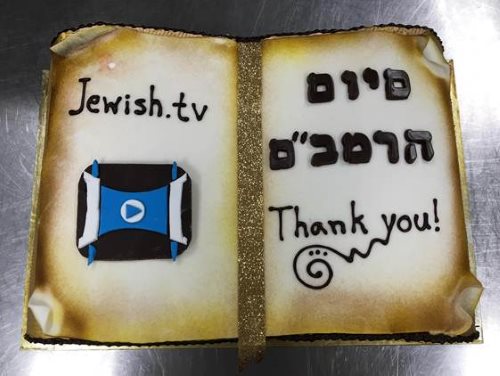
© Copyright 2015, all rights reserved.
Women
Morning in Jerusalem
By Elana Mizrahi
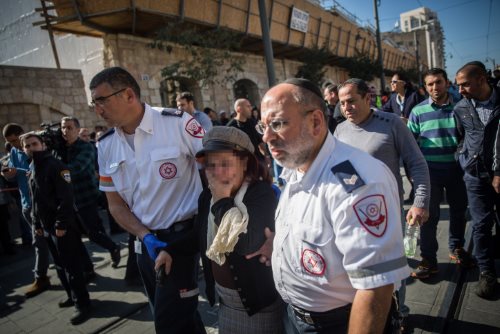
Emergency responders accompany a woman in shock following a stabbing attack on Jaffa Road. (Hadas Parush/Flash90)
I wake up, pray, make breakfasts and lunches. I help my children get dressed, argue with them about wearing a sweater or putting on a coat. This one needs help with her ponytail, that one needs help with his shoes. With a blessing and a kiss, I send them off to school.
I nurse my baby. I exercise. I have breakfast with my husband. The baby goes down for a nap. I’m able to see a client. Now I’m off to the doctor for an appointment. On the way home, five minutes from my home, I stop off at the shuk (market) to pick up some vegetables to make soup. I stop by my nut-and-almond man. I leave the shuk and walk onto Jaffa Road to my home.
Five minutes later. I’m home. The phone rings. Sirens, sirens. I hear the sirens. Another terrorist attack. Two Arab women stabbing civilians, a defenseless old man, among others. Where? On Jaffa Road, outside the food market, five minutes from my home.
I say Psalms. I pick up my baby and smother him with kisses. I give tzedakah (charity). I thank G‑d that I made it home. I send messages to friends and family that thank G‑d I’m okay.
I’m in shock. I shake myself. I look at the clock. Life. Reality. Get moving. Time to make lunch and supper. Time to fold laundry and put it away. The kids will be home from school soon. Life, an ordinary day for an ordinary wife and mother.
My mind can’t help but return to the sirens. Ambulances, police cars. I don’t understand these people. How can women do such things? I just don’t understand.
I don’t write this in the hopes that I can convince anyone of the obvious craziness of a people who only want to destroy and hate. I know that we are living in an era of darkness, and that there’s a reason that the world is blind. I write this to give myself, and maybe you, strength—to remember why we are here.
We are here to live! To continue, to bring light and holiness into this world. We have mission—not of hatred and murder, but of peace and life.
When Israel was enslaved in Egypt, Pharaoh issued a decree to kill all the Jewish baby boys by throwing them into the Nile. Amram, one of Israel’s leaders, heard the decree, wept and said: “Why bring children into the world for nothing?” He separated from his wife, and all the men in the generation followed his example.
His daughter, Miriam, said: “Father, your decree is worse than Pharaoh’s. He decreed only against the males, and you’ve decreed against males and females. He decreed death only in this world, and you’ve decreed both in this world and in the next. Pharaoh is evil, and chances are that his decree will not come to fruition, yet you are righteous—surely, your decree will come about!”
Amram listened and reunited with his wife, and all the men followed his example and reunited with their wives. (Talmud, Sotah 12a)
What happened then? Amram and Yocheved had another son, Moses, who grew up to be Israel’s humble leader—G‑d’s chosen redeemer. Moses merited the task of leading Israel out of Egypt to freedom. And Miriam, his sister, with her prophetic vision, her vision of life and hope, merited to see this all happen and take part in the redemption.
What was Miriam’s message—not just to Amram, but to all? The Nation of Israel must live! Keep going, living, doing. Have babies. Continue! Live! This is what we must do. Yes, it’s scary and dark out there, but G‑d gave us a distinct mission, a purpose. Make light! In this month of Kislev, of Chanukah and miracles. Make life. Create sparks of holiness. Know that just as G‑d did salvations and made miracles for our forefathers, so too does He make salvations and miracles for us today.
My thoughts as I, just an ordinary wife and mother, walk down the street? Please G‑d, let me live so that I can nurse my baby. Please G‑d, let my children and husband and all of Am Yisrael be safe. Let us see bar and bat mitzvahs, weddings and births. Let us live.
Originally from northern California and a Stanford University graduate, Elana Mizrahi now lives in Jerusalem with her husband and children. She is a doula, massage therapist, writer, and author of Dancing Through Life, a book for Jewish women. She also teaches Jewish marriage classes for brides.
© Copyright 2015, all rights reserved.
Women
When I Got to Planet Lubavitch By Lieba Rudolph

I've never actually had a conversation with an alien, but I do think I have some idea what it feels like to be one.
At our first authentic Shabbat experience almost 30 years ago, my husband and I landed on Planet Lubavitch, inhabited by women in wigs and men in beards. Even the planet’s name sounded strange. What kind of word was “Lubavitch”? My husband’s cousin had become a Lubavitcher several years earlier. What that meant to me was that she gave us Shabbat candlesticks for our wedding—in other words, what she wanted to give us. It I’ve never had a conversation with an alienseemed pretty obvious that she was trying to “convert us,” which served as ample proof that this thing called Lubavitch was a cult. I even imagined these people dancing euphorically on the street, not unlike members of other cults I’d seen in action.
But somehow we had ended up on this planet. And behind the wigs and beards there were real people, and some of them came from backgrounds not all that different from my husband’s and mine. Those were the people I was most interested in, the ones who had made a conscious decision to leave the reality of their birth. I hung on to every word of one man in particular, just because he had gone to Harvard. Why would someone like that become a Lubavitcher? Oh, I had lots of questions for him and everyone, but they had lots of answers for me, too. It was impossible to be insulting or irreverent to these interesting beings.
For reasons G‑d only knows, something happened at that cosmic encounter that compelled us to change course and never look back. I had been looking for truth in this world, and these Lubavitchers all seemed to have an otherworldly map telling them the way to find it. And that Shabbaton gave me a glimpse of the map: by keeping the G‑d-given commandments, I could help bring Moshiach and the world of truth I craved.
After that weekend, I began suiting myself up for life on this new planet. I’m sure that more than one person looked at my husband and me and thought that Chabad (which is synonymous with Lubavitch) got us just like they got his cousin who gave us the candlesticks.
But most people don’t get gotten, certainly not these days. It’s almost mainstream to party with Chabad and even pray with Chabad. (Okay, and give tzedakah to Chabad.) But you don’t have to become Chabad.
But once I got to Planet Lubavitch, I soon understood that getting gotten—seeing and knowing G‑d in everything—is what I’m here to do. Although this would mean recreating my entire being, the Lubavitcher Rebbe’s teachings could help me every step of the way.
What did it take to become a Lubavitcher?
When asked what it meant to be a chassid, the fifth Lubavitcher Rebbe, Rabbi Sholom Dov Ber, answered, “A chassid is a lamplighter.” The analogy continues by saying that just as a lamplighter ignites the street lights of a town, a chassid takes responsibility for igniting his own soul in order to help those around him. He does not live for himself and instead strives to give to others whatever he has and knows.
That’s A chassid is a lamplighternot an easy mandate. (Maybe it’s a good thing they didn’t mention any of that at the Shabbaton!) After we moved to Planet Lubavitch, there were times of uncertainty; sometimes I second-guessed my decision. But I know now that everything was meant to be, that it came from somewhere high above the heavens.
Occasionally, I wonder what my life would have been like had we not traveled this way, but that gets harder and harder to imagine, since with G‑d’s help our children and grandchildren are now an inextricable thread in the fabric of life here. (What a bonus: Planet Lubavitch is sustainable!)
But as good as it is, life on Planet Lubavitch could be so much better. The Rebbe assured everyone that a better reality is imminent, that heaven and earth are about to merge with the arrival of Moshiach. The exact details of how this will happen, I don’t know. I just know the Rebbe is counting on me to do everything in my power to make it a reality in this world.
Lieba Rudolph lives in Pittsburgh, PA, and writes a weekly blog about Jewish spirituality.
© Copyright 2015, all rights reserved.
Jewish News
How One Purple Book Revolutionized Kosher Cooking
By Dovid Margolin
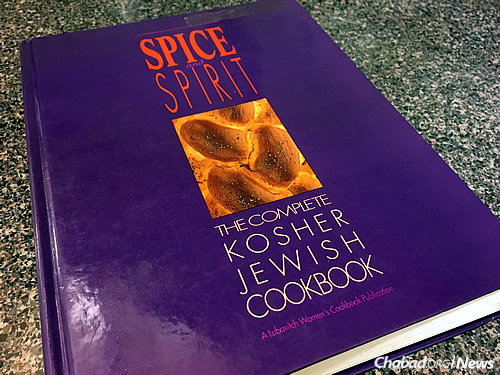
Since adopting a purple cover for the second edition in 1990, the groundbreaking “Spice and Spirit” has become widely known as “The Purple Cookbook.”
Steaming-hot chicken soup with carrots, a fluffy matzah ball sitting in the golden broth. Potato latkes piled high, covered with a healthy dose of sour cream or applesauce. And gefilte fish—that sometimes maligned but secretly loved mixture of ground carp, eggs, matzah meal, pepper and sugar, eaten with the mandatory chrein (Yiddish for “horseradish”).
Jewish food has a way of stirring up our fondest memories: a grandmother’s Formica kitchen, a snowy Chanukah evening, a traditional Shabbat meal.
The powerful connections between tradition, memory and food were not lost upon the small group of tenacious volunteers who first published The Spice and Spirit of Kosher-Jewish Cooking nearly four decades ago. At a time when Jewish cookbooks were mostly limited to spiral-bound Sisterhood fundraisers, Spice and Spirit—widely referred to as the Lubavitch Women’s Cookbook—packed hundreds of kosher recipes into a professionally designed heavy-duty volume. It quickly made a place for itself on cookbook shelves in kitchens from Chassidic Brooklyn, N.Y., to the suburbs of Los Angeles.
“It’s an extremely valuable and monumental work,” says legendary cookbook guru Nach Waxman, who founded Kitchen Arts & Letters—a specialized cookbook store containing more than 13,000 titles—on New York’s Upper East Side in 1983. Over the years, Spice and Spirit’s recipes have appeared in media outlets from Hadassah magazine to The New York Times, representing authentically kosher food to the world. The book has since been followed by a generation of modern kosher cookbooks.
“The kosher cookbook market has since exploded, but Spice and Spirit was a trailblazer,” attests Waxman. “It’s one of those important standard works. It introduced a lot of people in the Jewish world to the idea that kosher goes far beyond tzimmes and kugel.”
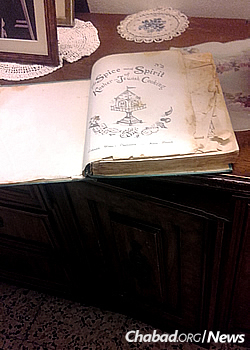
The kosher cookbook's first edition was published in 1977 and became a staple in Jewish homes.
“People were starting to travel more and experience other cultures, and the Lubavitch cookbook introduced new kosher recipes,” adds Joan Nathan, the doyenne of Jewish cooking who contributes recipes and articles to The New York Times and Tablet Magazine, and whose first Jewish cookbook, The Flavor of Jerusalem, came out in 1975.
The book also stood out because of its pages detailing kosher laws, instructions for celebrating Jewish lifecycle events, and elegantly written explanations on the meaning of Shabbat and the holidays.
The finished product belied the fact that the book hadn’t been produced in the publishing houses of Manhattan, but in a handful of dining rooms and kitchens in the Crown Heights neighborhood of Brooklyn by a volunteer team of 14 women, led by Esther Blau, Cyrel Deitsch and Cherna Light. What drove the women—at the time all stay-at-home-mothers raising large families—was a passionate dedication to sharing the mitzvah of keeping kosher with Jewish people everywhere.
Sustenance for the Soul
It was 40 years ago that the Lubavitcher Rebbe—Rabbi Menachem M. Schneerson, of righteous memory—introduced his newest mitzvah campaign, kashrut (keeping kosher). For some time already, his followers had been hitting the streets to urge their fellow Jews to don tefillin or light Shabbat candles, but in the summer of 1975, the Rebbe called on Jewish people everywhere to place a special emphasis on kosher, explaining that its laws have an acute impact on a Jew’s spiritual health.
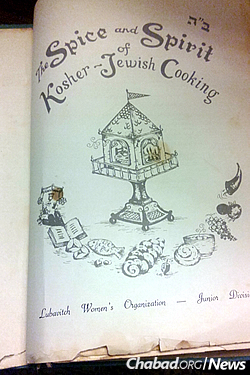
The cookbook revealed to many that quality kosher cooking did not have to be limited to kugel and tzimmes.
“It is explained in holy Jewish books ... that a person’s makeup is greatly affected by what he eats and drinks,” stated the Rebbe. “The food becomes a part of his blood and flesh, and just like it affects one’s physical health, it affects one’s spiritual health as well.” The Rebbe also pointed out that modern science has come to recognize the effects food has on the entirety of the person as well.
Shortly thereafter, the Lubavitch Youth Organization in New York announced Chabad’s newest campaign. During his talk, the Rebbe had spoken of a special fund that would offset the costs incurred by an individual going kosher; the notice laid out the details:
A fund has been established to help defray costs of anyone, throughout the entire world, who will change to a kosher kitchen—kasher the stove and other utensils, purchase two new sets of dishes and whatever else is necessary. Half of all these expenses will be reimbursed from this special Kashrus Fund upon receipt of a letter from the local rabbi certifying that the kitchen has been kashered and the amount of the expenses incurred. This will, of course, be kept in utmost confidentiality.
Within days, Chabad activists were working on the mechanics of helping people kosher their homes. Educational pamphlets were printed, and utensils for koshering sinks and stoves purchased.
“I remember we received brochures from New York for us to send out within our communities,” says Rabbi Shimon Lazaroff, regional director of Chabad-Lubavitch of Texas since 1973. “We started dealing with kashrus; it was all we talked about. Hundreds of homes went kosher here in Houston during that time.”
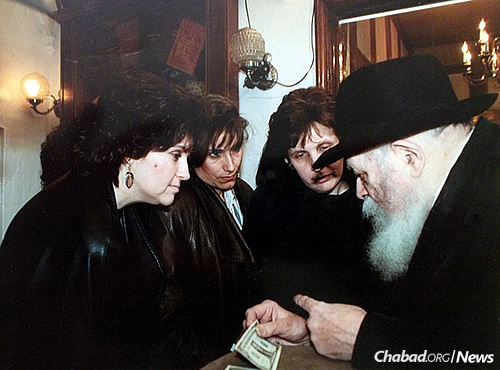
The editorial committee of the cookbook, from left, Cherna Light, Cyrel Deitsch and Esther Blau, receive dollars and a blessing from the Lubavitcher Rebbe—Rabbi Menachem M. Schneerson, of righteous memory—for their work.
Meanwhile, just a few years earlier, the younger division of the Lubavitch women’s organization based in Crown Heights—had voted to create a community cookbook not unlike the ones published by synagogues, schools and Jewish women’s groups around the country.
“Cyrel Deitsch, Marilyn Rosenfeld, Fraida Andrusier and Frida Schapiro were in charge of the recipes,” remembers Blau, who has served as the longtime editor-in-chief of the cookbook. “It was very primitive, all by hand. Women didn’t write recipes in any professional order; it was totally amateur. We collected and tested, and we probably had quite a few hundred recipes.”
The women were also sensitive to the new influx of people into the community who were discovering Jewish practice, and wanted their book to serve as a kosher source and an all-around Jewish reference for the women who hadn’t grown up in religious homes.
“We had people write a little about kashrut, a little bit about the holidays, maybe a half-page for each,” says Blau. Recognizing that they needed an expert to oversee the kosher-law section, Blau asked Rabbi Yehuda Kalman Marlow—at the time one of the rabbis of the Crown Heights community—for his help.
“That first manuscript was reworked numerous times, and he went over everything very, very patiently,” recalls Blau. “We submitted it to the Rebbe in 1975.”
The Rebbe’s response was not what the women were expecting.
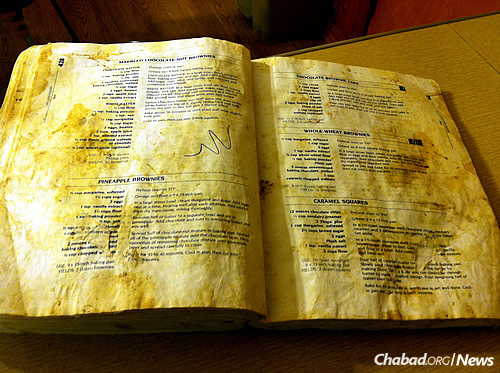
The book became glued to Jewish kitchens; the typical volume is replete with handwritten notes, food stains and flour smudges.
Make It Beautiful
The answer came in the form of a detailed, handwritten response by the Rebbe in Hebrew, typed up by his secretary, Rabbi Binyomin Klein.
The cookbook would be vying for attention with other ones on the market, the Rebbe said, non-kosher ones included, so:
Since this will have an effect on kosher observance in many Jewish households, it needs to be beautiful externally as well, even if it will cost more to create. Surely, you’ll consult cookbooks that are already sold in stores.
The committee was invigorated by the Rebbe’s challenge and support.
“When we got these instructions, we recognized that the Rebbe attributed far more importance to what we were doing than we had ourselves,” says Blau. “We immediately started consulting professionals. We knew it had to be typeset and not off a typewriter. Everything had to be done on another level. It had to be beautiful.”
The written sections were rewritten and expanded. Artist Michoel Muchnik was commissioned to illustrate the book and the front cover. As the project grew, so, too, did interest in it.
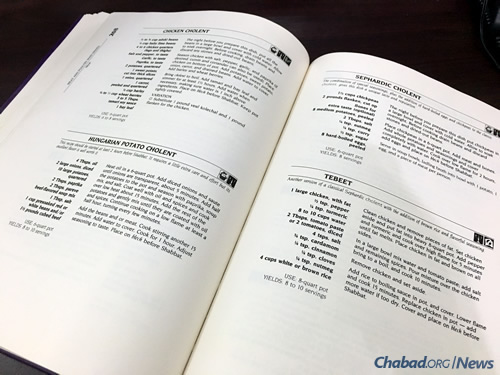
Clear, simple and easy to follow, “Spice and Spirit” raised generations of kosher cooks. While modern dishes were included, Jewish classics still kept their place in the pantheon. More than just a collection of recipes, it included pages detailing kashrut, Shabbat and the Jewish holidays.
Cyrel Deitsch, whose cooking and hostessing skills would prove to be a great asset over the years to the Spice and Spirit endeavor, remembers their meeting with Macmillan Publishers: “The woman there was very nice, and they wanted the book, but they didn’t want to print it at the level we wanted it. We wanted it on good paper, and during that time all the cookbooks were being printed on this thin type of paper. We also learned that at all of these big corporations, you’re just as good as your promoter. If your promoter leaves or is fired, no one cares about your book anymore, and it goes straight to the bottom of the pile.”
So they forged on. The women soon discovered that with nothing like it on the market, everybody from the bookbinders to the printers were excited to take part in the project, graciously extending credit on numerous occasions. The heads of these companies—often Jews who were raised with some traditional observance—considered it their privilege to help see a first-ever kosher cookbook of this caliber into fruition.
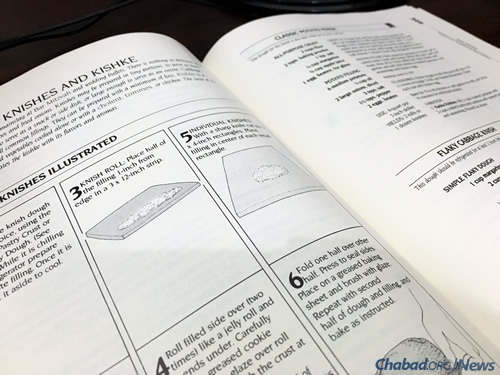
The collection of recipes cam complete with “how to” illustrations and included pages detailing kashrut, Shabbat and the Jewish holidays.
Throughout the process, each iteration of the book would be presented to the Rebbe, who would offer detailed critiques and instructions.
By 1977, it was finally ready. At that year’s farbrengen gathering held at 770 in honor of the 50th anniversary of the release of the Rebbe’s father-in-law—Rabbi Yosef Yitzchak Schneersohn, of righteous memory—from Soviet imprisonment in 1927, the Rebbe was presented with the finished product. Visibly pleased, the Rebbe responded with a blessing: “Much success with the kosher campaign, and all of the mitzvah campaigns!”
Towards the end of the gathering, the Rebbe further accentuated the significance of the work, telling the thousands gathered about the newly completed book and pointing out that no less important than it being a beautiful guide to cooking, it was also a kosher primer.
Food columnists and reviewers seemed to agree, applauding the fact that they finally had a comprehensive and explanatory kosher cookbook they could use as a reference.
“Because rules for kosher cooking prohibit the mixing of meat and dairy products, cookbooks devoted to such recipes usually resort to awful ersatz ingredients that result in tricked-up ‘mock’ this or that,” wrote Mimi Sheraton in the Times. “One exception is ‘The Spice and Spirit of Kosher-Jewish Cooking.’
“This large, handsome, illustrated book includes descriptions of all religious requirements for maintaining a kosher home,” emphasized Sheraton, “along with instructions for the proper observance of Jewish holidays and life-cycle celebrations.”
The initial printing flew off the shelves. Jewish people from all walks of life lapped up Spice and Spirit; they simply loved it.
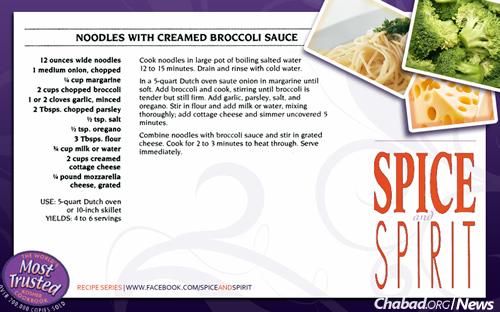
The book's Facebook page offers a glimpse of some recipes and interaction with readers.
The Second Phase
While each consecutive printing of the Spice and Spirit would rapidly sell out, by the mid-1980s it became obvious to the ladies of the cookbook committee that it was time to update their bestseller. The book—a blue hardcover edition wrapped in a linoleum-yellow dust jacket—contained older recipes (rendered chicken fat, for example, known as gribnes) that didn’t have to be included in a newer book.
Consumers were also clamoring for kosher versions of everything from more modern American cuisine to Asian-inspired foods and ingredients then just gaining in popularity.
Deitsch remembers years of weekly meetings with her fellow committee members, mainly Blau and Light, as well as hours testing the various new recipes included in the new edition. Light had joined the group in 1985, bringing her culinary skills and knowledge of modern foods to the effort.
Meanwhile, Blau recounts that “the Rebbe was very anxious about the book’s release. I remember when Rabbi Nissen Mindel, one of the Rebbe’s secretaries, came out of the Rebbe’s office, saying that the Rebbe asked about the cookbook’s status. There were many other times as well; it was clear that the Rebbe wanted it published as soon as possible.”
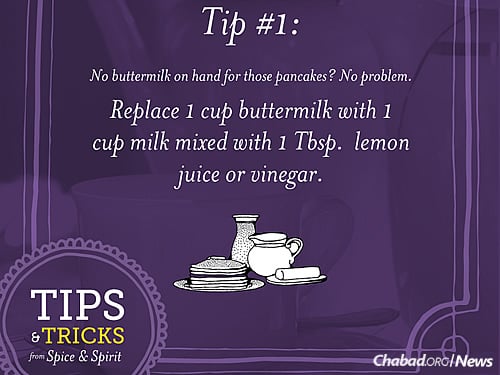
Recipes often call for kosher ingredients that can be difficult to find in typical stores. Although times have changed and much more is available these days, “Spice and Spirit” is dotted with helpful tips such as this one.
With work in full-swing Waxman got a call from Blau asking if they could get his advice on moving forward with an updated copy.
“She said they were doing this new edition of the book and asked if I could consult with them,” says Waxman. “A few women came in, and we talked very seriously, at a very high level; we discussed everything from cover design to the nature of the recipes to publishing.”
Waxman and other professionals who became involved with the new book were impressed by how precise and organized the work was—this from already busy women who between the three of them were raising dozens of children. “What they accomplished was spectacular,” declared Waxman. “I find it difficult to see how this group of people with so many other obligations could even begin to put together something on this level. This book leaped the fence between community cookbooks and professional ones.”
In all, the new edition would include almost 900 recipes. The kosher-law, Shabbat and Jewish holiday section, which takes up about a third of the book, was rewritten and expanded by Tzivia Emmer and Tzipora Reitman to make it more accessible and practical. In addition to other design changes, a distinct purple cover was chosen, from which it has since taken its most famous moniker, “The Purple Cookbook.”

Reprinted numerous times over the years, the book has sold more than 200,000 copies.
Its Effects Spill Over
The “Purple Cookbook” was released amid much fanfare in 1990, published with the slightly altered title of Spice and Spirit: The Complete Kosher Cookbook. By now, everyone had taken notice. The book came in third place in the Tabasco Community Cook Book Awards; it was included in anthologies such as The New York Times Jewish Cookbook; and its recipes were published in national magazines like Good Housekeeping.
Joan Nathan, who included recipes from Spice and Spirit in her best-selling anthology—an excerpt of which was published as a pre-Rosh Hashanah profile of Deitsch and kosher cooking for The New York Times in 1991—met Cyrel in 1991 when she was doing Jewish Cooking in America. “She invited me to her house in Crown Heights for Shabbat, and I came there with two of my children. We had a great time.”
What fascinated Nathan was how the Chabad-Lubavitch community was integrating foods introduced to them by baalei teshuvah—returnees to Jewish practice, such as Rivkah Katzen and Shulamis Nadler—who by that time made up a sizeable number within the Chabad community.
“There were people who hadn’t been kosher, and had experienced other styles of cooking and then brought that into the community,” says Nathan, who has written 10 cookbooks and is working on her 11th. “The other thing was that in my experience, so many of the Lubavitchers, such as Cyrel, were really good cooks.”
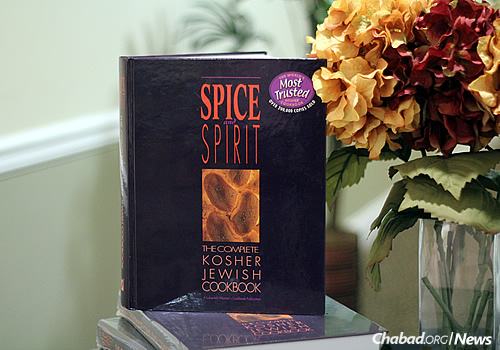
“The Purple Cookbook” has become one of the world's most trusted Jewish resources. It continues to sell well today, 25 years since the second edition came out.
Nathan says she still refers to the cookbook, noting that it’s one of very few that includes so comprehensive a guide on kosher laws. “The practices were very interesting,” she says. “It was religious, but at the same time not parochial, not preachy.”
“The Purple Cookbook” has certainly entered the bloodstream of Jewish and kosher cooking in America, helping countless numbers of Jews learn about, and ultimately commit to, keeping kosher. Beyond regular consumers, Spice and Spirit is also often used by caterers and other professionals learning about kashrut.
Its effects, says Blau, are difficult to estimate, and they’re not all food-related.
Take, for example, the time in the mid-1980s when her phone rang incessantly very early in the morning.
“The call was from Russia, and I couldn’t decipher it at all, but someone was urgently trying to reach me,” she remembers. Finally, Blau asked her Russian-Jewish secretary to come translate.
A Jewish refusenik had been arrested in Russia, and the woman on the line wanted a blessing from the Rebbe. She had no way of getting in touch with anyone in New York, but she did have the kosher cookbook, which listed Blau’s phone number on the inside cover. The woman’s request was passed on to the Rebbe’s office at 770.
“The Purple Cookbook” can be bought online and in stores, and while by now there’s no shortage of kosher cookbooks, Spice and Spirit still stands out as a testament of dedication to a mission and the superhuman feat of a small group of volunteers.
“When someone walks in and asks for one book that orients them on kosher, I will give them this book,” affirms Waxman. “We will always keep it on our shelves.”
To learn more, visit the cookbook website here.* * *
Hungry? Here’s a recipe from Page 137 for “Classic Chicken Soup”:
Chicken soup is the ideal Jewish dish. Ever popular for Shabbat and Yom Tov, it is perfectly complemented by egg noodles or kneidlach. Lovers of chicken soup are quite passionate about the best recipe; each cook has his or her own favorite.

Chicken soup, in all its various forms, is a staple on Shabbat tables and Jewish holidays.
Classic Chicken Soup
Ingredients:
1 3-pound to 5-pound chicken, quartered
12 cups water
3 carrots
1 stalk celery
1 to 2 parsnips
1 onion
1 Tbsp. salt
¼ tsp. pepper
Optional:
1 parsley root
1 clove garlic
Several sprigs of fresh dill
1 sweet potato
1 zucchini
Use:
8-quart pot
Yields:
8 to 10 servings
Clean chicken and remove excess fat.
Fill an 8-quart pot with 12 cups of water. Bring to a boil.
Place chicken and vegetables in pot. Add salt and pepper. If using optional ingredients, chop parsley root; peel garlic, leaving it whole, pierce with toothpick in order to remove easily. Add both to soup with the dill. Dice the sweet potato, slice zucchini and add to soup.
Simmer, covered, for about 2 hours. Remove garlic.
Serve hot.
Note: To remove excess fat, prepare soup in advance and refrigerate for several hours overnight. Fat will congeal on top. Remove and heat soup before serving.
© Copyright 2015, all rights reserved.
Jewish News
Israeli Teen Killed at Highway Gas Station; Second Young Victim Laid to Rest
By Chabad.org Staff
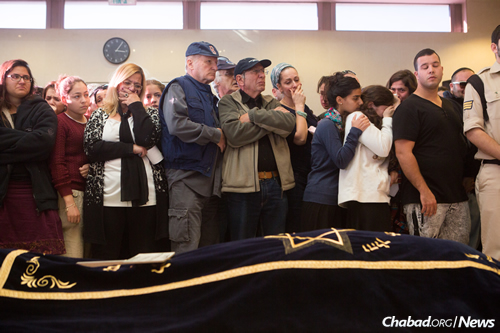
Mourners at the funeral of 21-year-old Hadar Buchris, who was killed by terrorists. (Photo: Miriam Alster/Flash90)
JERUSALEM—A few hours before 21-year-old Hadar Buchris, murdered by terrorists on Sunday, was laid to rest at Har Menuchot cemetery in Jerusalem, another young Israeli—an 18-year-old—was killed in a terrorist stabbing attack at a gas station on a highway between Jerusalem and Modi’in.
Two others were hurt in the attack along highway 443. An Israeli woman was lightly stabbed and evacuated to the Shaare Zedek Medical Center in Jerusalem. Another woman was lightly hurt when her car was accidentally hit by gunfire from police.
Today’s victim, whose name has not been released, is the 22nd person to die at the hands of terrorists in Israel since the beginning of October.
Earlier in the day, two Palestinian teenage girls from northern Israel stabbed a 70-year-old Arab man near the popular Mahane Yehuda outdoor market in Jerusalem. Both attackers were shot by a local resident who rushed to the scene while they were continuing to attack passersby. One terrorist died at the scene; the other was taken to a nearby hospital in critical condition.
A few hours later Hadar Buchris, a resident of Tzfat who was murdered Sunday while waiting for a ride to Kiryat Arba at a hitching station in Gush Etzion, was laid to rest in Jerusalem.
A native of Netanya, Buchris attended school in Safed and the Golan Heights, majoring in theater. She then completed two years of national service working with children and teens, first at a moshav near Tiberias, then at a kibbutz in Beit She’an.
Her family said she would be buried at the Har HaMenuchot cemetery since “she truly loved Jerusalem. She was very connected to the city, so in the holy city she shall be laid to rest.”

Medical personnel accompany a woman in shock from the scene of a stabbing attack near the Machane Yehuda outdoor market in Jerusalem. (Photo: Hadas Parush/Flash90)
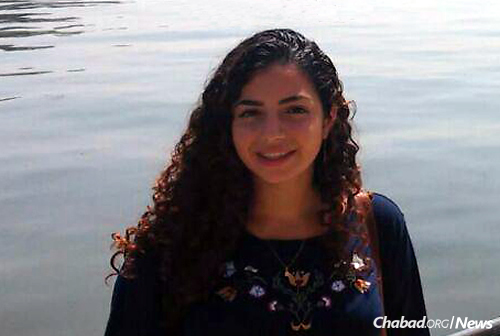
Hadar Buchris
© Copyright 2015, all rights reserved.
Jewish News
Toronto Kids Learn About Giving Back
By Chabad.org Staff
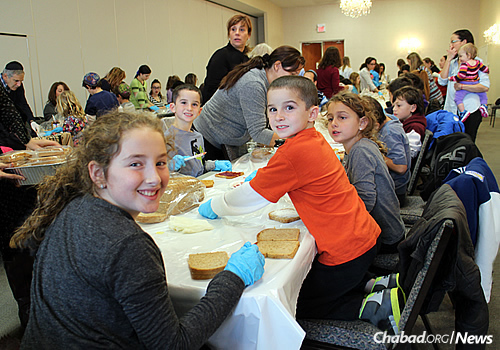
More than 120 volunteers made 500 sandwiches for the homeless at a new program in Canada.
How do you raise Jewish kids of character, teaching them the value of giving back to their community?
Under the leadership of youth coordinator Mattie Schurder, a new program at Chabad Lubavitch of Markham in Thornhill, Ontario, enables families with children ages 5 to 16 to embrace real-life charitable opportunities—away from the virtual world that many kids live in today.
On Sunday, Nov. 29, local families will wrap Chanukah gifts for children hospitalized during the holidays. The event partners with Chai Lifeline, an international organization that helps families cope with pediatric illness, loss or tragedy.
“We are very excited to be bringing this program to the community,” said Allison Solomon, co-chair of Chabad of Markham’s Sisterhood group. “We look forward to welcoming anyone who wants to show their children the gift of giving back. Children learn through our actions, and this is a very exciting platform to enable parents in our community not just to ‘talk the talk, but to ‘walk the walk.’ ”
At the first event held on Nov. 1, the Chabad center partnered with Ve’ahavta (a Jewish charity service) to make sandwiches for the homeless in Toronto. More than 120 people made 500 sandwiches and designed cards that were attached to the sandwich bags.
“I felt great,” said 10-year-old Cody Solomon. “I always get things, and now it was my time to give back to people who don’t have as much as we do.”
Joanne Herr, a mother of three, reported that “watching my children making sandwiches for the less fortunate—and watching the excitement grow with each sandwich being produced—was priceless.”
For more information and to sign up for the Nov. 29 event, visit here.
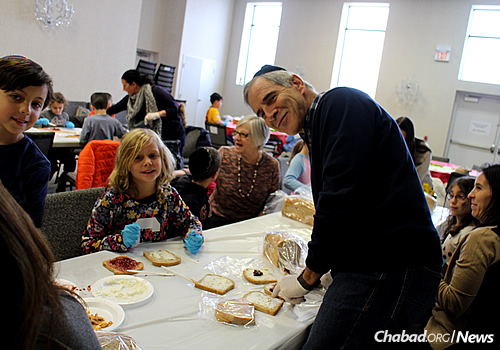
Geared for children ages 5 to 16 , the program offers hands-on experiences that give back to the community.
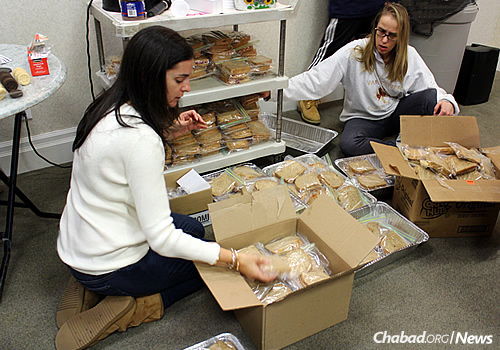
Teenagers pack the freshly made sandwiches for distribution.
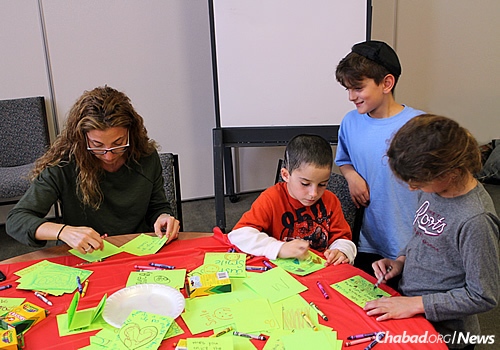
The kids and their parents also designed cards that were attached to the sandwich bags.
© Copyright 2015, all rights reserved.
Jewish News
Saint-Denis Rabbi’s Pledge: Our Public Menorah Will Shine Even Brighter This Year
By Faygie Levy Holt
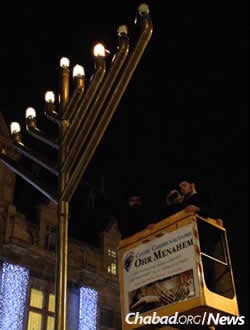
The 2013 outdoor public menorah-lighting in Saint-Denis
When Chanukah begins at sundown on Sunday, Dec. 6, residents of the Saint-Denis neighborhood of Paris will be able to count on an uplifting tradition this year despite major terror attacks that have rocked and unnerved the city this year: the outdoor menorah-lighting that has been a neighborhood celebration in Saint-Denis for decades.
“We’ve been doing it for 24 years ... we should stop now? No, we’re going to make it even better than in other years,” affirmed Rabbi Mendel Belinow, director of Beth Chabad S.-Denis & La Plaine. The menorah is but one of hundreds of outdoor menorahs that will be on display throughout Paris again this year.
The rabbi made his remarks from his home in the Saint-Denis neighborhood just hours after police raided a nearby building where suspected armed terrorists were hiding. Two people, including a female suicide bomber who triggered an explosive, were killed and seven other alleged terrorists were arrested, according to reports.
The incident came just days after 129 people were killed on Nov. 13 in multiple terror attacks that targeted recreational areas and restaurants.
Then, on Wednesday evening, Rabbi Tsion Saadon, a Chabad-Lubavitch school teacher in Marseille, was stabbed by three assailants. Reports indicate the attackers uttered anti-Semitic phrases and declared themselves ISIS supporters while knifing the teacher, whose injuries are reported as non-life-threatening. The attack follows on the heels of an Oct. 24 incident, also in Marseille, in which three Jewish residents were stabbed outside a synagogue.
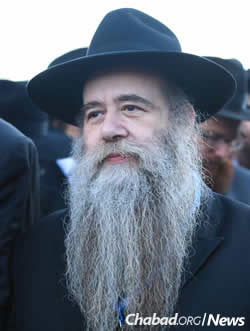
Rabbi Mendel Belinow, director of Beth Chabad S. Denis & La Plaine
Discussing the police action in Saint-Denis earlier in the day, Rabbi Belinow said that the authorities approached the area around 4 a.m. Hearing the commotion, he stepped outside to see what was happening. He was quickly ordered back inside, where he remained for most of the day. The Chabad House and community center, which includes a shul, a mikvah, the Ohr Menachem day school, a catering hall and a pizza shop, are just a few meters away from the police activity.
The building, like most everything in the Saint-Denis area, was closed for the day.
Saint-Denis is home to some 15,000 Jews and a very large Muslim population.
Recounting the events of this morning, Belinow said: “It was like a war. I never, never saw such a thing. Thank G‑d, there were no injuries to people in our community and we’re also relieved that there was no damage to the Chabad House.”
He has been fielding phone calls all day from concerned Jewish community members, in addition to local residents offering their support.
The rabbi emphasized that it is important for people to keep going and to be strong. He says he personally takes strength in knowing that he is a shaliach—an emissary of the Lubavitcher Rebbe, Rabbi Menachem M. Schneerson, of righteous memory—fulfilling his mission.
In response what seems to be a spate of terror attacks in the world Belinow responded the way any Chabad rabbi would, saying “we have to do more, give more.”

Chabad centers are dedicated to making sure that menorah-lightings take place all over Paris, despite terror attacks that have rocked the city this year, including one on Friday at the national sports stadium.
© Copyright 2015, all rights reserved.
Jewish News
Guests From Around the World Heading to Grieving Couple's Wedding
By Faygie Levy Holt
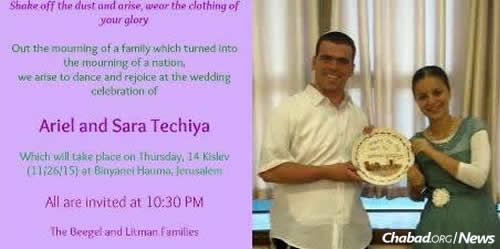
Ariel Biegel and Sarah Techiya Litman have invited the world to their wedding. Her father and brother were killed by terrorists less than two weeks ago.
It would have been understandable if Sarah Techiya Litman and Ariel Biegel of Israel decided to have a private, low-key wedding. After all, their original wedding date, Nov. 17, had to be postponed after Sarah’s father and 18-year-old brother, Yaakov and Netanel Litman, were killed by terrorists just days before the wedding while en route to a pre-wedding celebration.
Instead, the couple has decided to invite Jews everywhere to join them. Among the thousands of expected guests will be many who are coming from as far as Australia and the United States, representing family and friends back home. To accommodate the crowds, the wedding has been relocated to the Jerusalem International Convention Center.
“Don’t let our enemies rejoice. We have fallen and we have risen,” wrote the couple. “With G-d’s help, our wedding will take place next Thursday, 26 November, 14 Kislev, at Binyanei Hauma in Jerusalem. The Jewish nation is invited to rise from the dust and celebrate with us.”
Inspired by the couple’s faith, courage and optimism, several Chabad Houses and Chabad on Campus branches have been holding raffles over the past few days to send communal representatives to the wedding. In Melbourne, Australia, and Ottawa, Canada—and in a number of cities in the United States—individuals are donating funds for a chance to win the airfare to attend the wedding this Thursday evening.
The wedding and its large gathering—thousands are expected to attend and fulfill the commandment of being joyful and celebrating with the bride and groom—comes as Jews celebrate the Hakhel year, where unifying gatherings of Jewish men, women and children of all ages are encouraged, with an emphasis on learning Torah.
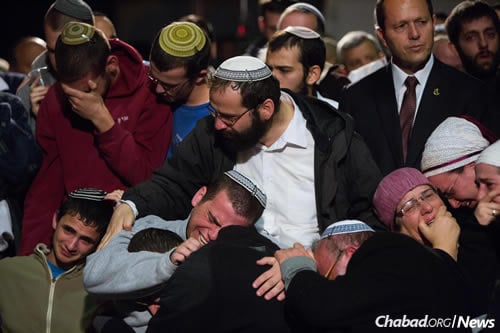
Hundreds gathered at the the funeral of Rabbi Yaakov Litman and his son Netanel, who were murdered by terrorists while driving to the pre-wedding celebration. Less than two weeks later, Litman's daughter invited the Jewish world “to get up from the dust and rejoice with us.” (Photo: Yonatan Sindel/Flash90)
“This initiative presents our community with a tangible and meaningful way to express our solidarity, love and support with the people of Israel,” says Rabbi Aaron Slonim, executive director of the Rohr Chabad Center for Jewish Student Life at Binghamton University in Upstate New York. “Beyond that, we join in the deep resolve of this couple that terror not define our lives, and that goodness and kindness and joy fight the wave of darkness and despair that seems so overwhelming.”
Binghamton University is one of the Chabad centers sending someone to the wedding.
The communal outpouring of support for the betrothed, both in their 20s, was simply overwhelming in Australia, says Rabbi Dovid Gutnick, co-director of Chabad East Melbourne. “In just two days, over 150 people entered the raffle, and many others just chose to donate.”
And a tour operator in Israel offered the winner free sight-seeing excursions around Jerusalem, according to Gutnick, who adds that “the response has been incredible.”
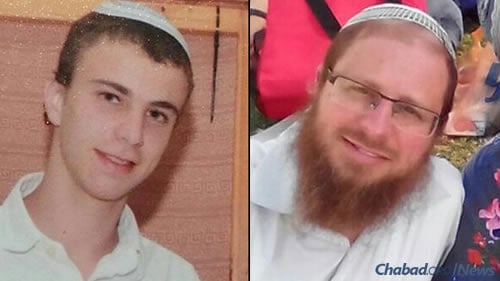
Rabbi Yaakov Litman, 40, right, and his son Netanel, 18
‘The Story of the Jewish People’
Velly Slavin, adult-education director of Chabad of Malvern in Australia, noted in a post on Facebook that they have not only raised enough money to send a community representative to the wedding, but to also deliver a “substantial wedding gift to the young couple.”
“We thank the Australian Jewish community for the outpouring of support that will surely bring comfort and joy to the young couple,” Slavin said in his posting.
Also holding raffles for a chance to attend the wedding are the Chabad Student Center at Einstein in the Bronx, N.Y.; the Rohr Chabad Student Network of Ottawa in Canada; Chabad on Campus in Queens, N.Y.; and Chabad of Southwest Broward in Florida.
A representative will also be attending the wedding on behalf of Chabad in southern New Jersey. Three local centers—Chabad Lubavitch of Camden County in Cherry Hill, the Israeli Chabad Center in Voorhees and Chabad of Medford—teamed up to raise funds for the couple and to send a local resident to attend the wedding on their behalf.
Rabbi Mendel Solomon, director of Chabad of Short HIlls, N.J. booked a flight for his wife Chana Devora as soon as they heard about the wedding. She'll be representing the Short Hills community at the celebration and will be bringing a gift for the newlyweds on their behalf.
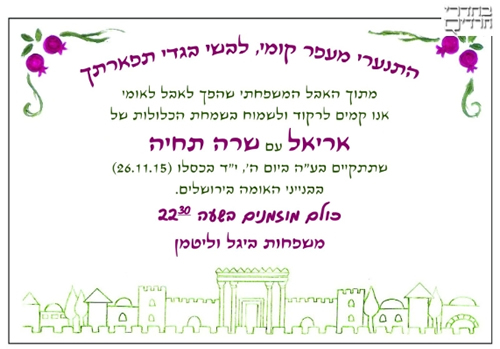
Expecting thousands of guests, including visitiors from overseas, the wedding has been moved to Jerusalem's International Convention Center.
“We have no doubt they will be very touched that the Jewish community of South Jersey is thinking of them, mourning with them and now celebrating with them,” says Rabbi Menachem Kaminker, co-director of the Israeli Chabad Center and editor of the Hebrew edition of Chabad.org.
The murder of Sarah Litman’s father and brother distressed Jews worldwide, but it hit the Chabad community in Israel particularly hard; Yaakov Litman taught first- and second-grade students at the Gan Chabad in Kiryat Arba, where the family lives.
Kaminker feels that so many individuals are rallying around Sarah Litman and her groom because their situation resonates everywhere. “I think it’s because this is truly the story of the Jewish people and how, despite all kinds of setback and tragedies, we still carry on,” he says. “And not only do we carry on, but we reach for higher places—in this case, the building of a home and family.”
Gutnick readily agrees: “Despite the current and historical challenges and tragedies, we are an unbreakable family. And when we are united, we will prevail and we will thrive. That is the lesson of history, and that is what we are doing now.”
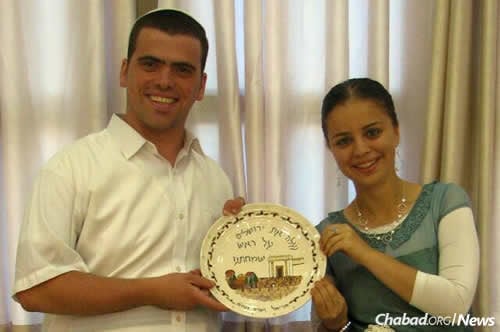
Ariel Biegel and Sarah Techiya Litman at their recent engagement party
© Copyright 2015, all rights reserved.
Lifestyle
Fried Mozzarella Sticks for Chanukah By Miriam Szokovski
Ooey, gooey, yummy, cheesy . . . does it get any better than breaded, fried, melty mozzarella cheese?
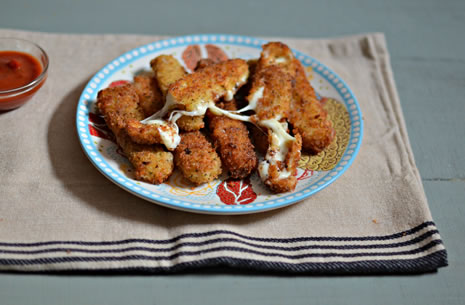
This recipe combines two elements of traditional Chanukah food—cheese and oil.
Why oil? After winning the war against the Syrians, the Maccabees returned to Jerusalem to liberate it. They entered the Temple and cleared it of the idols placed there by the Syrian vandals. Since the Temple’s golden menorah had been stolen by the Syrians, the Maccabees now made one of cheaper metal. When they wanted to light it, they found only a small cruse of pure olive oil bearing the seal of the high priest. It was sufficient to light the menorah only for one day, but by a miracle of G‑d it continued to burn for eight days, till new oil was made available, which is why we celebrate Chanukah for eight days. Because of the miracle of the oil, it’s traditional to eat fried foods on Chanukah (like doughnuts and latkes).
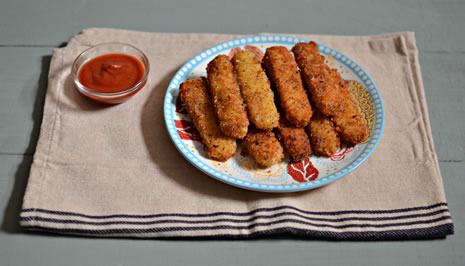
It is also customary to eat dairy foods on Chanukah, in commemoration of the bravery of Yehudit. Click here to read the story of this brave woman whose daring courage led to a great Maccabee victory.
So these fried mozzarella sticks are a perfect Chanukah combination. You can even plate them in the shape of a menorah.

The two most important things to keep in mind when making this recipe are:
Make sure you freeze the breaded cheese for at least 30 minutes before frying.
Make sure your oil is not too hot, otherwise the crumbs will burn and the outer layer of melted cheese will push its way through the crumbs and stick all over the bottom of the frying pan, while the inside stays frozen. In other words, you will end up with an inedible, burned mess.
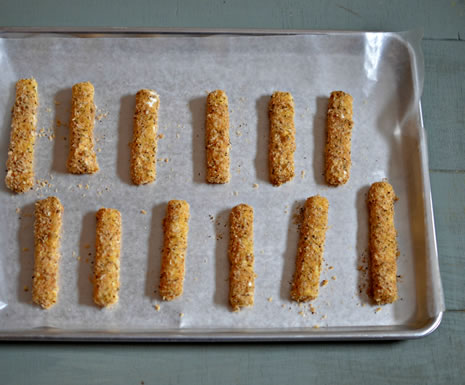
Other than that, it’s pretty simple!
Ingredients:
10 mozzarella sticks (you can use string cheese, or cut a block of cheese to size)
1 egg, beaten
¼ cup flour
½ cup flavored Panko crumbs
Oil for frying
Marinara sauce for dipping (optional)
Directions:
Coat each cheese stick in flour, then dip in egg and coat with the crumbs.
Place the coated cheese sticks on a tray or plate lined with wax or parchment paper. Freeze for 30 minutes.
Heat the oil to medium, then drop 2–3 sticks in the oil. Cook until brown on one side, then gently flip and cook until the other side is lightly browned. Remove from pan and place on a piece of paper towel.
Serve immediately, with warm marinara sauce for dipping (optional).

Miriam Szokovski is the author of the historical novel Exiled Down Under, and a member of the Chabad.org editorial team. She enjoys tinkering with recipes, and teaches cooking classes to young children. Miriam shares her love of cooking, baking and food photography on Chabad.org’s food blog, Cook It Kosher, and in the N’shei Chabad Newsletter.
© Copyright 2015, all rights reserved.
Lifestyle
Artwork of the Week: Shabbat Shalom! By Rae Chichilnitsky
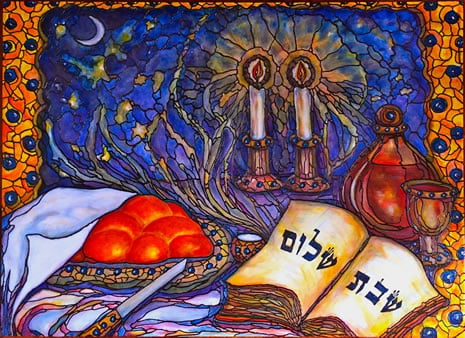
Artist’s Statement: The subject is pretty self–explanatory. Through the use of traditional elements and vivid colors, I wanted to convey to the viewers the very special, celebratory side of Shabbat. I’d hope that by looking at this artwork, people experience as much joy as I did while painting it! The painting is done in my trademark style, which I call “Stained Glass on Canvas.”
Rae Chichilnitsky is a freelance artist and illustrator whose work involves multiple genres, media, applications, subjects and techniques. Despite her secular upbringing, Rae always gravitated toward the spiritual. Some of her recent work reflects the wisdom, light and beauty she has discovered through Torah study.
© Copyright 2015, all rights reserved.
Chabad.org Magazine - Editor: Yanki Tauber
----------------------------
No comments:
Post a Comment